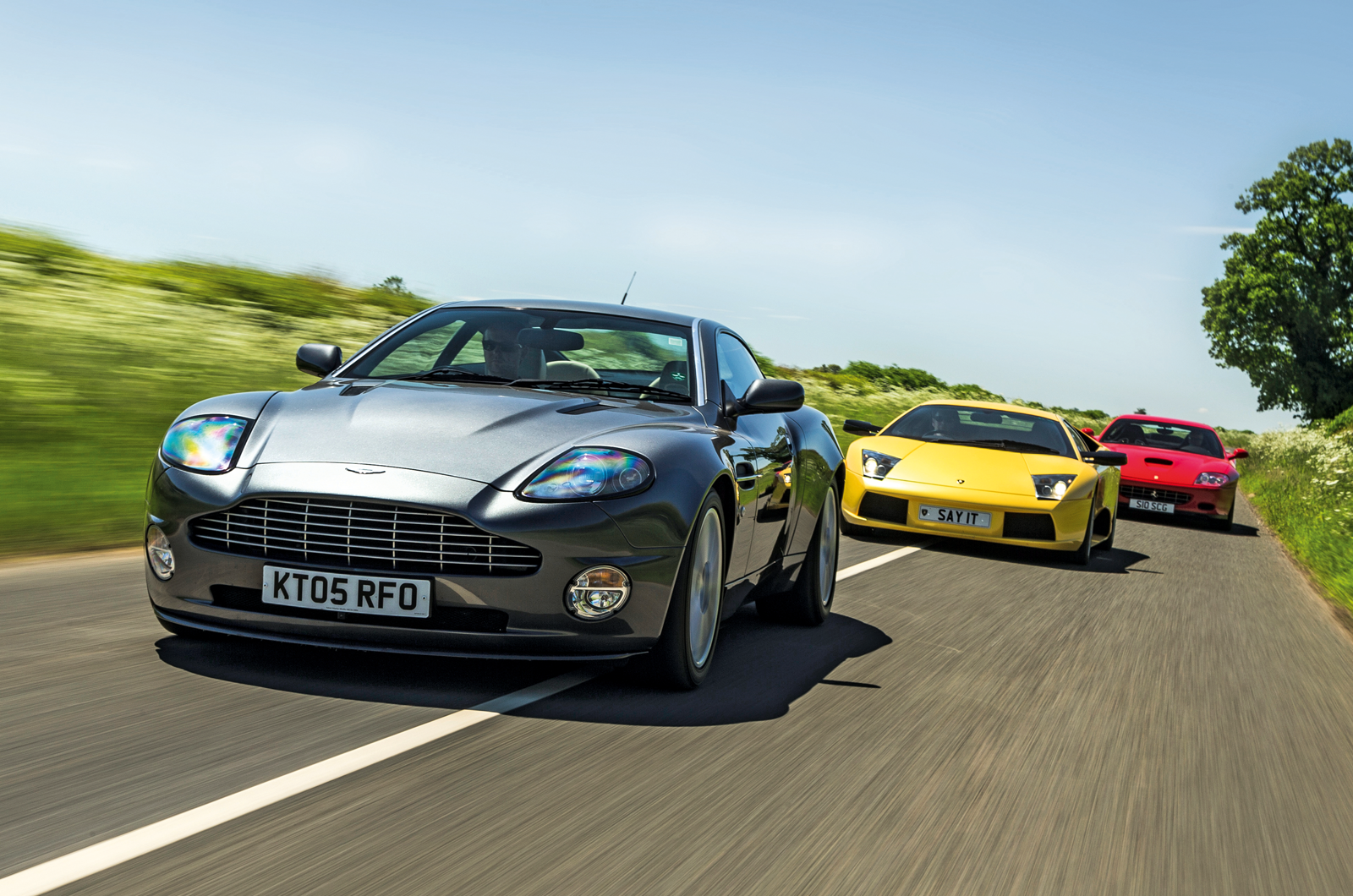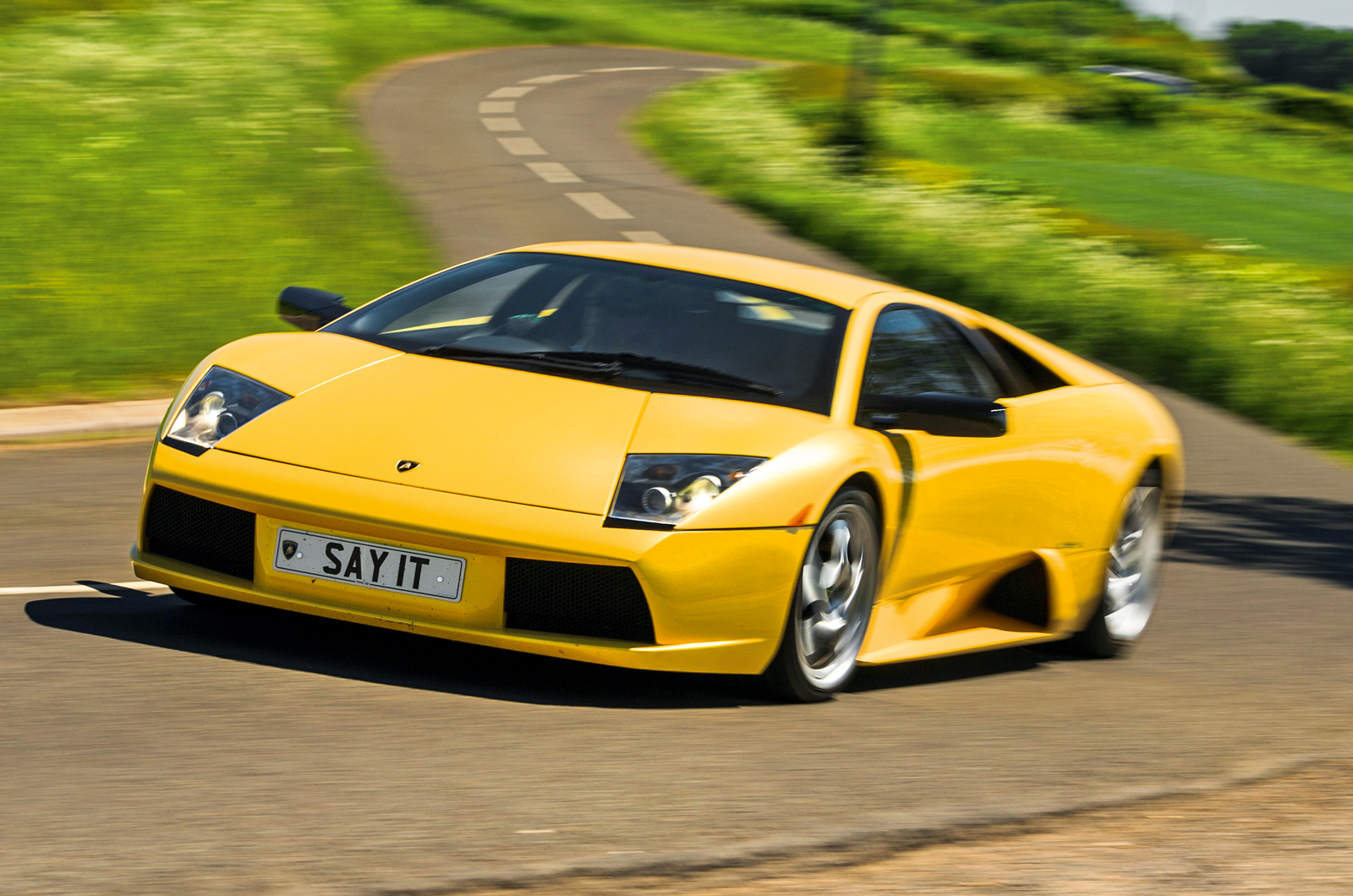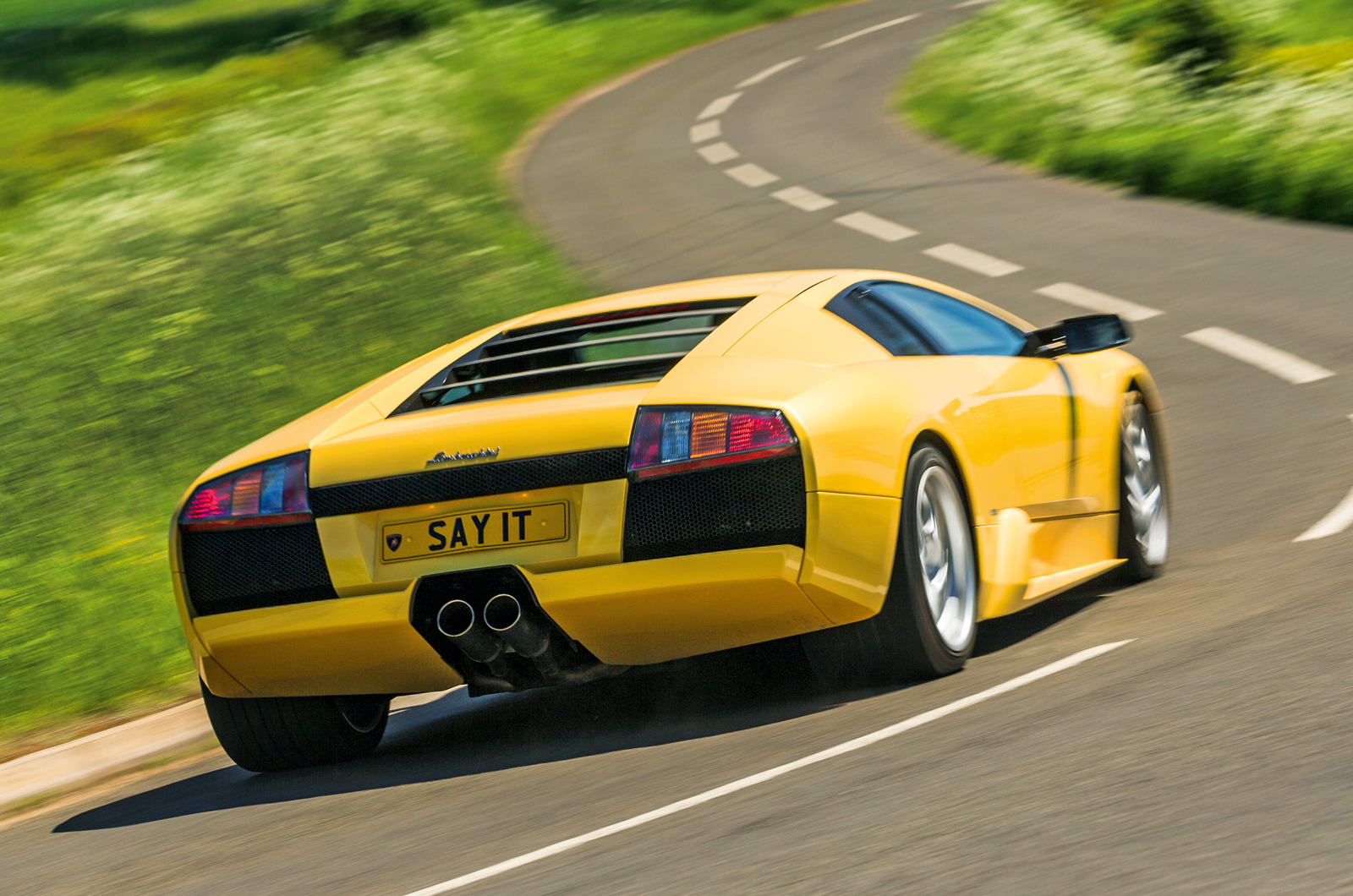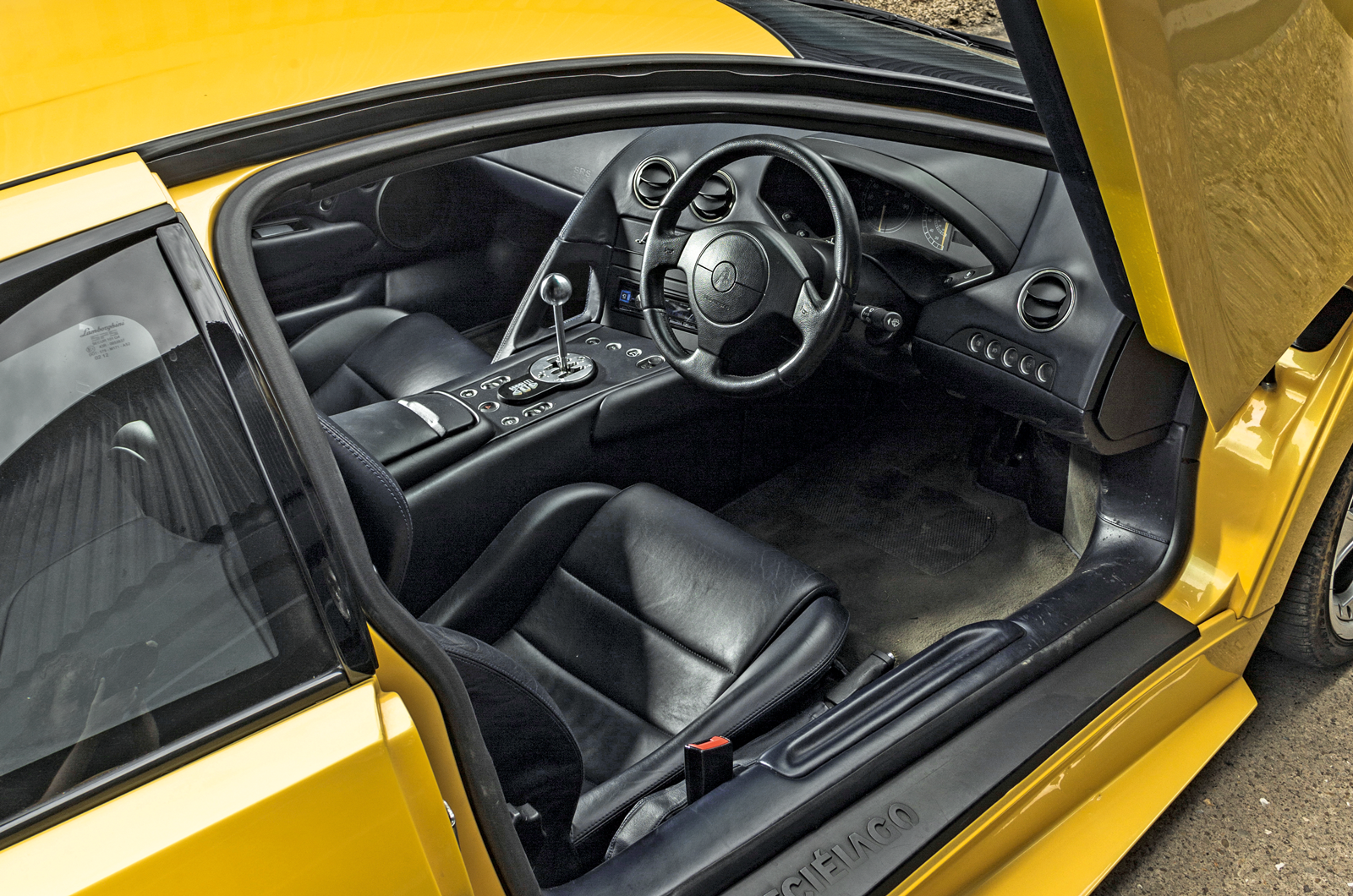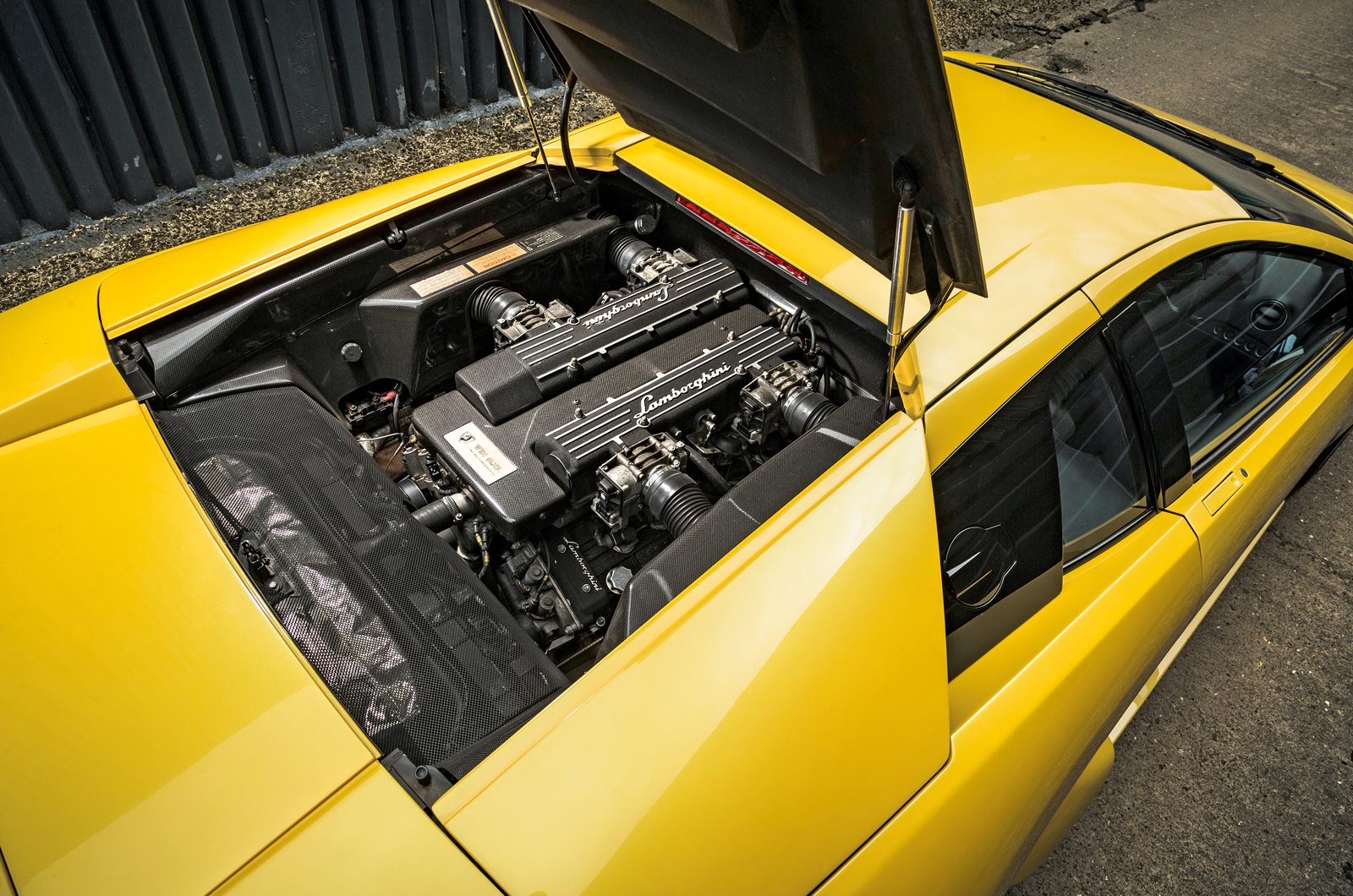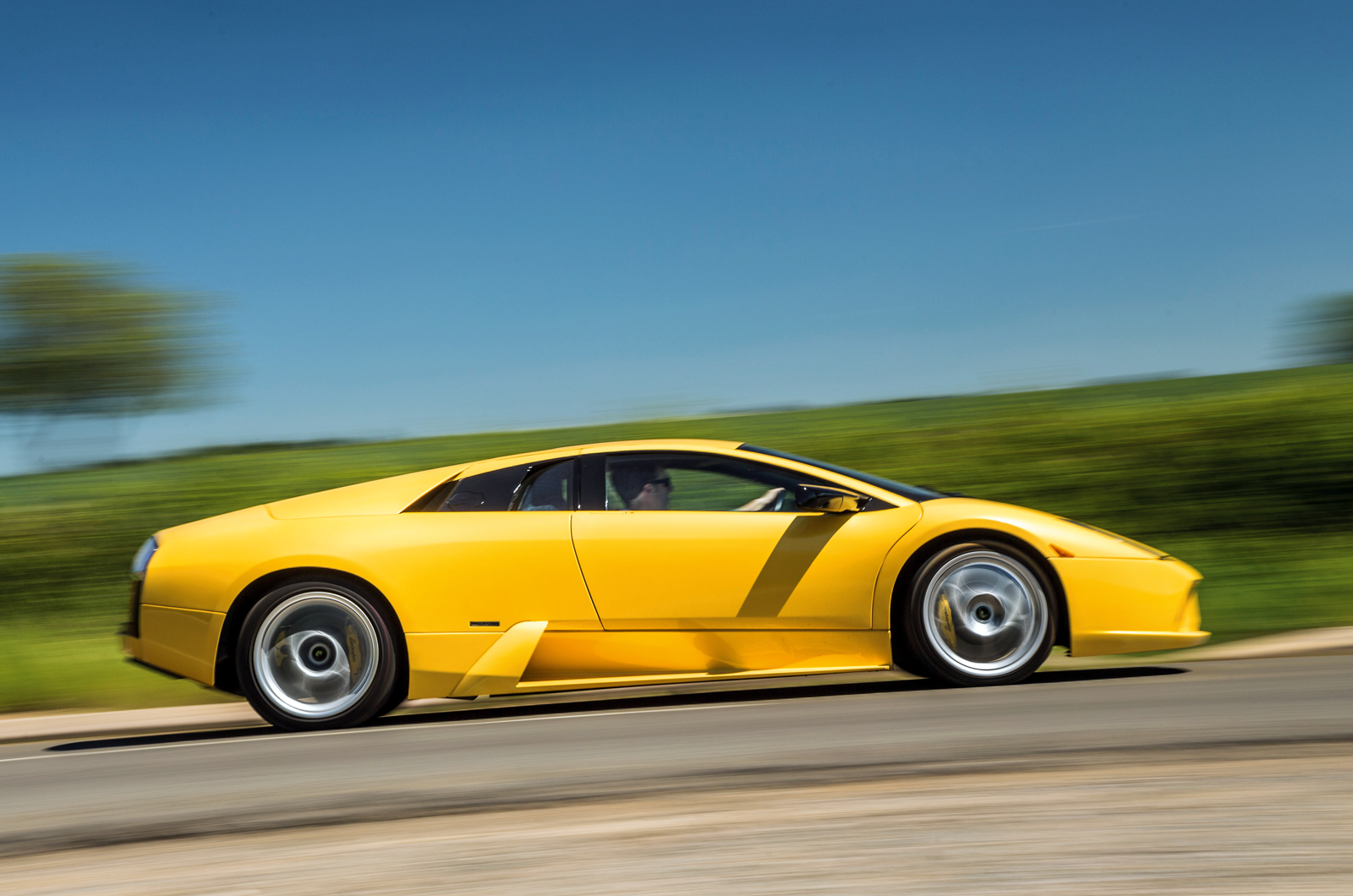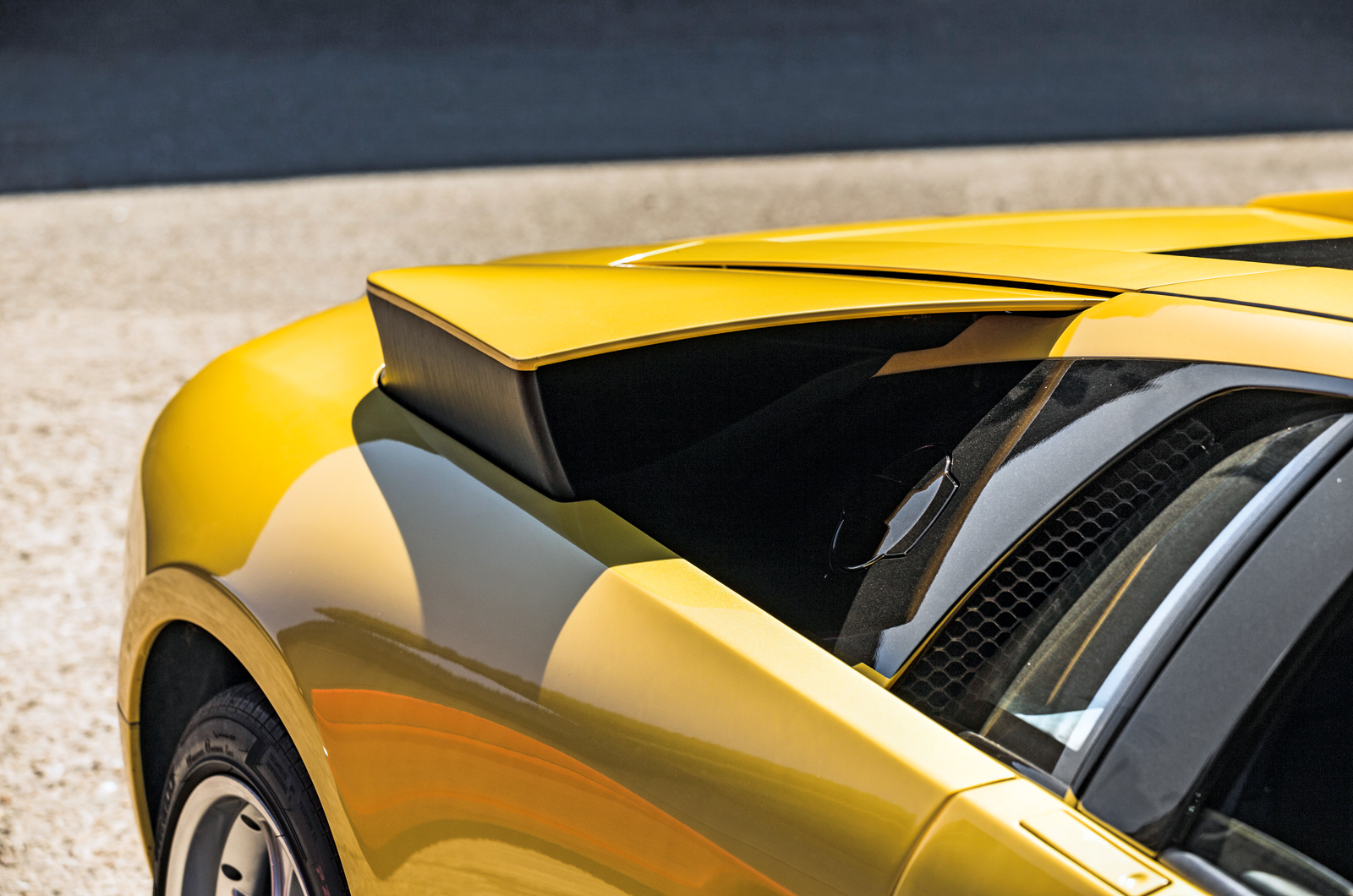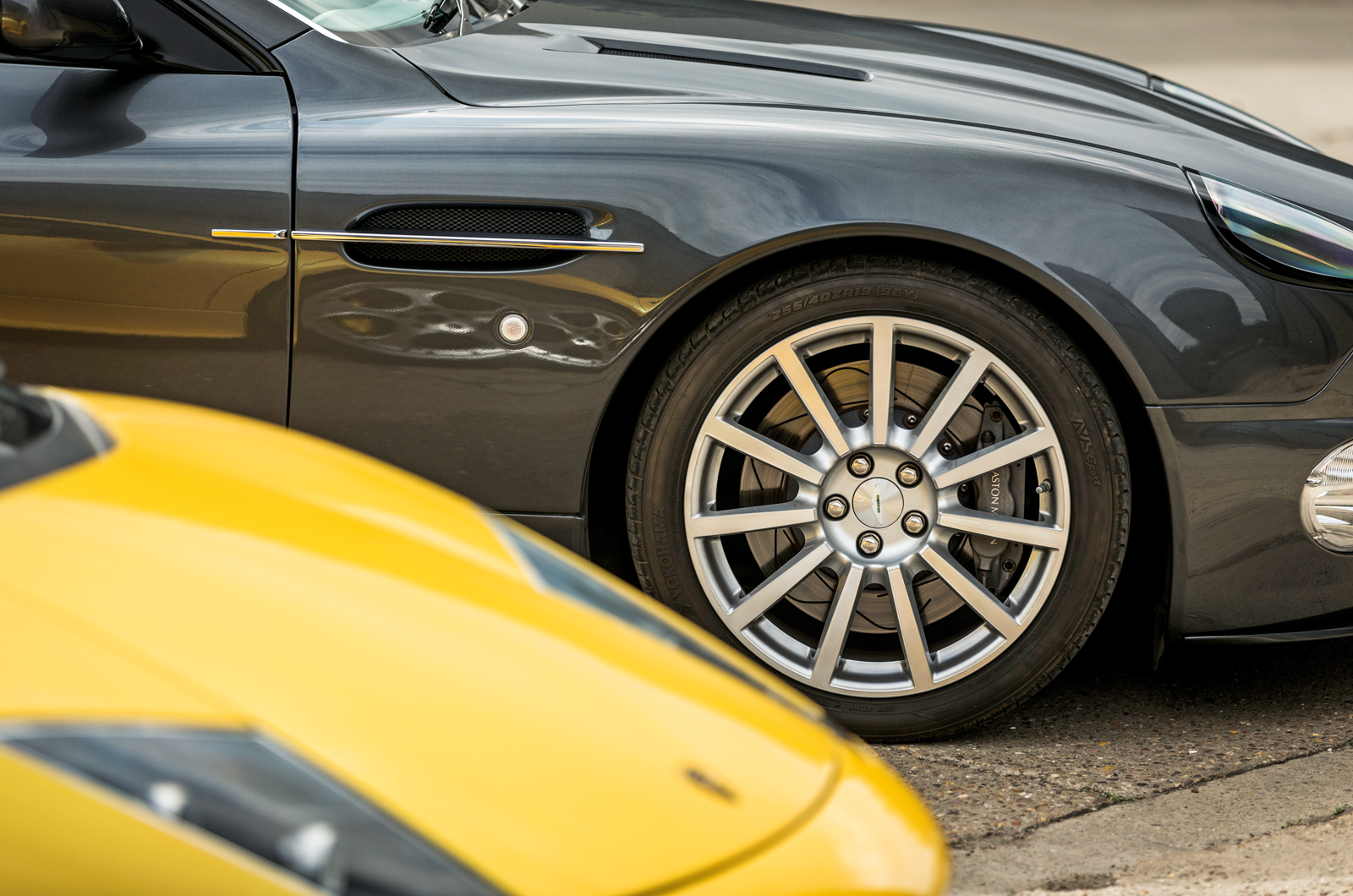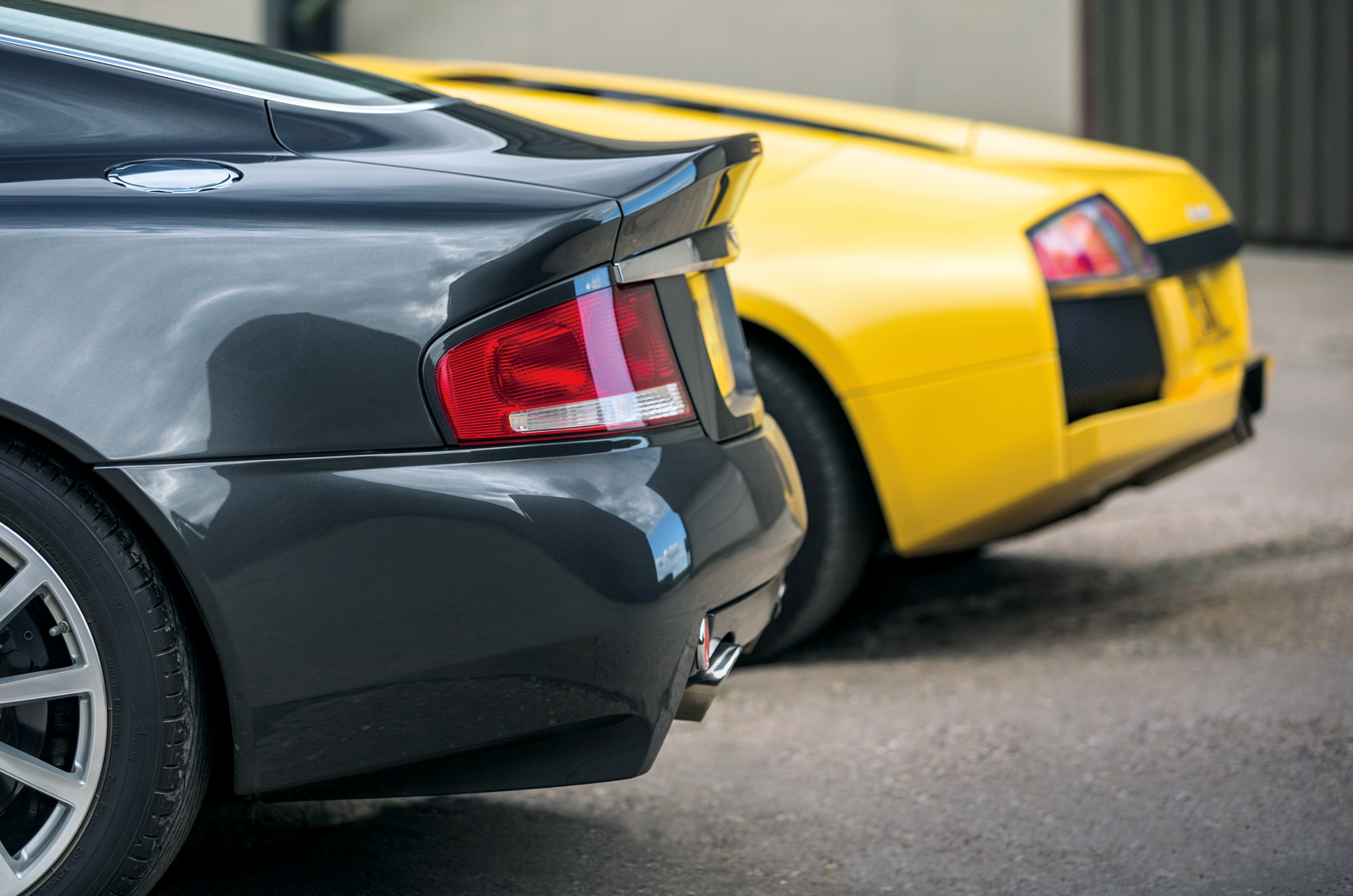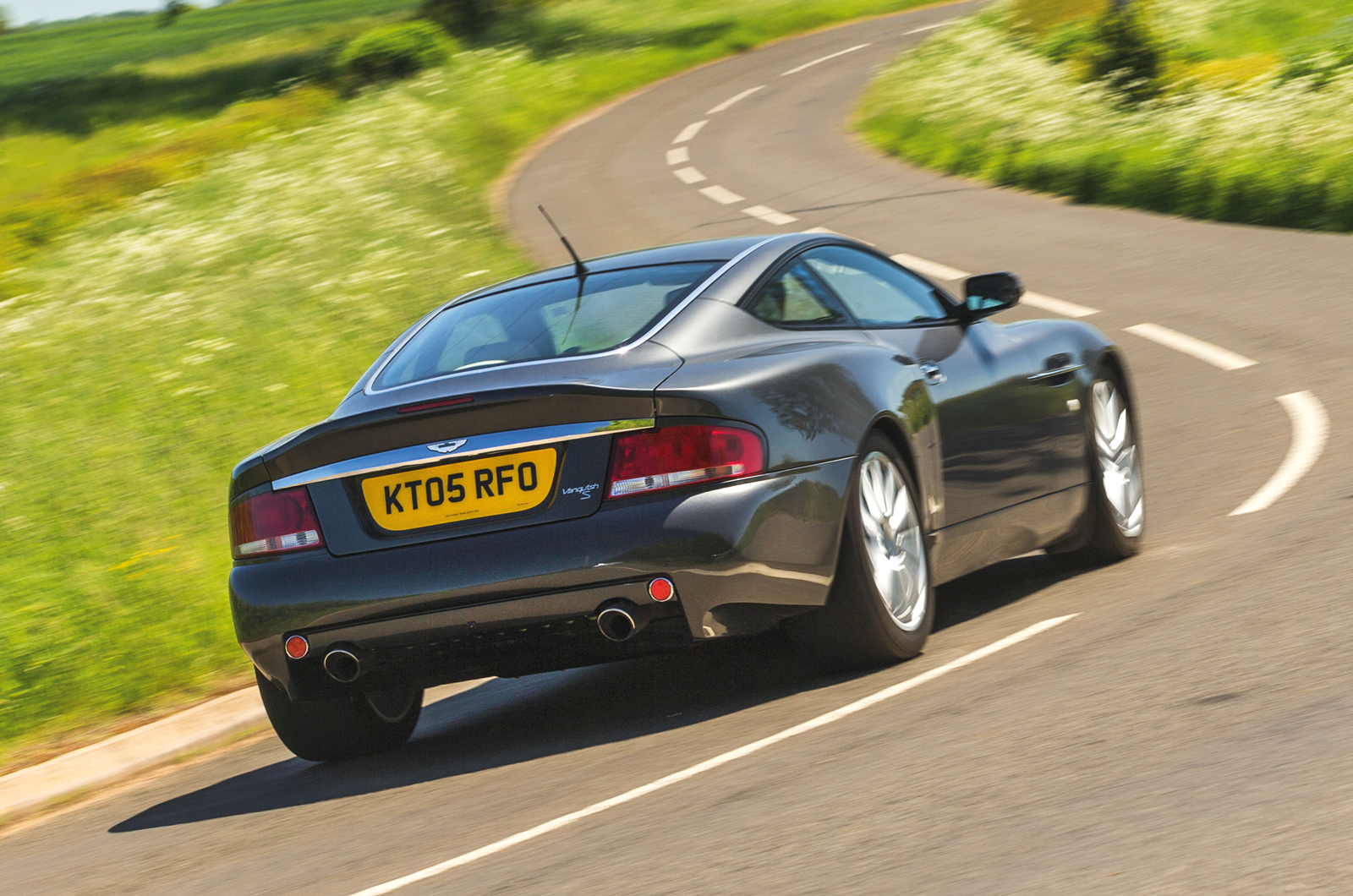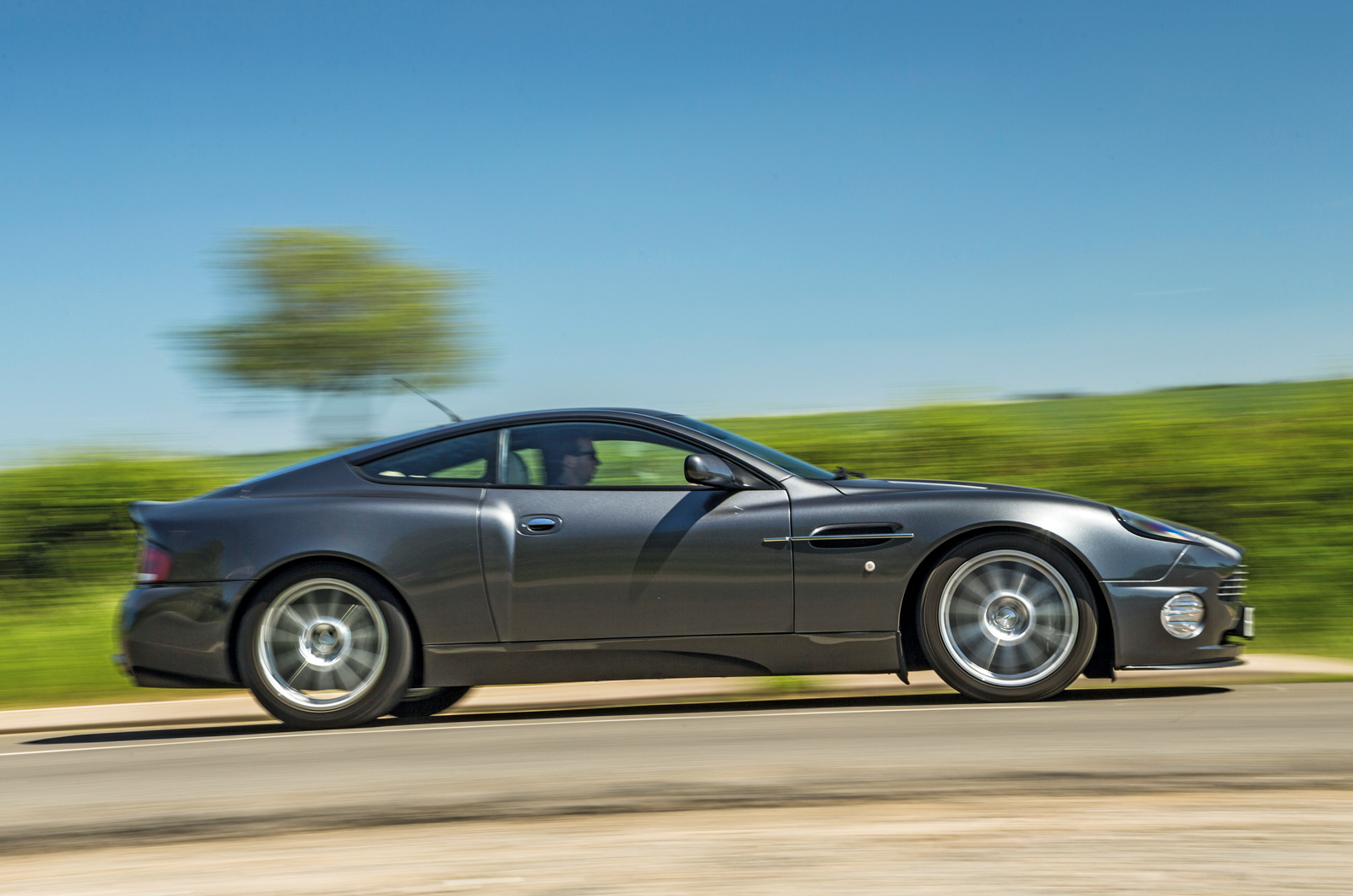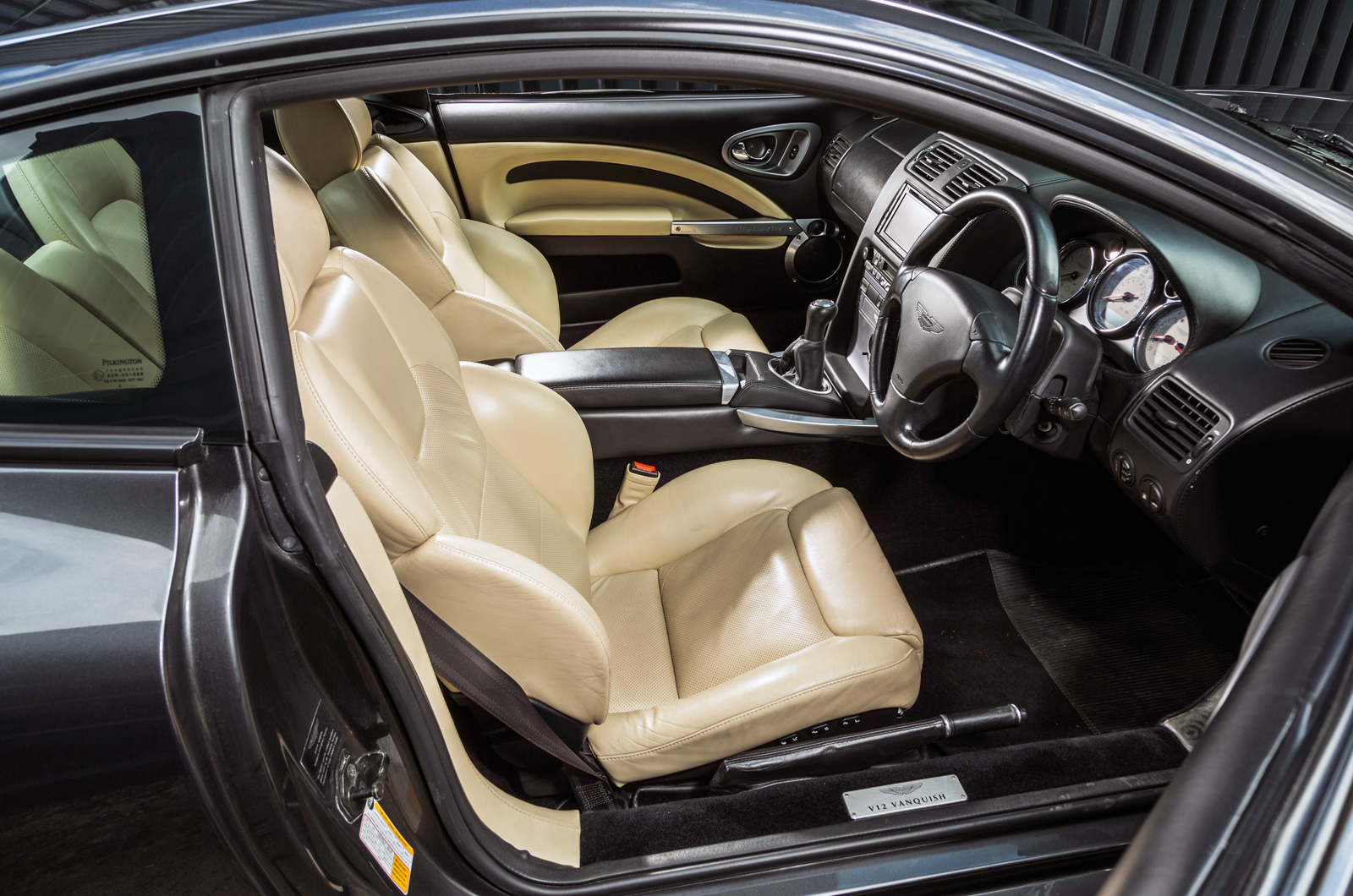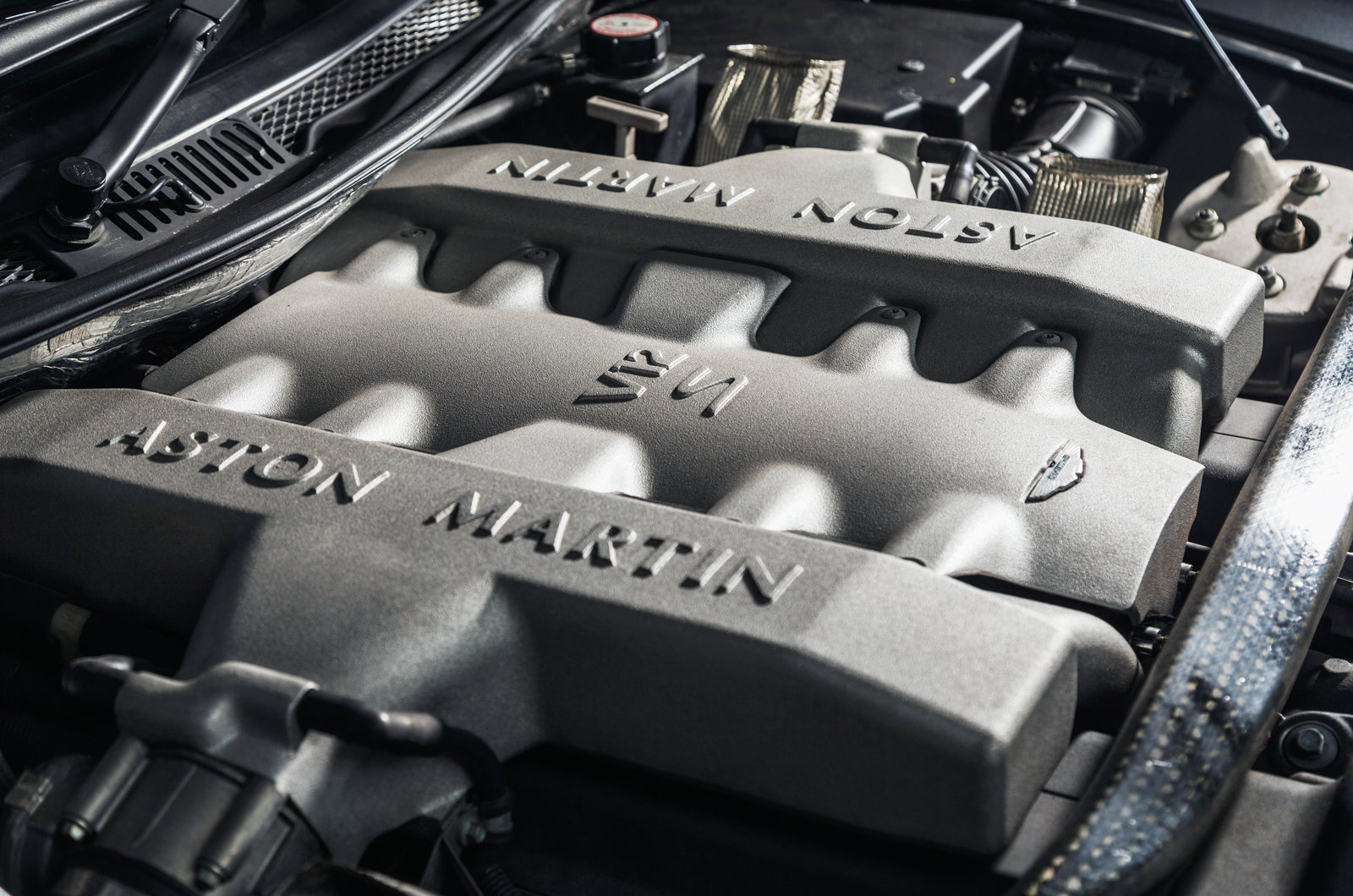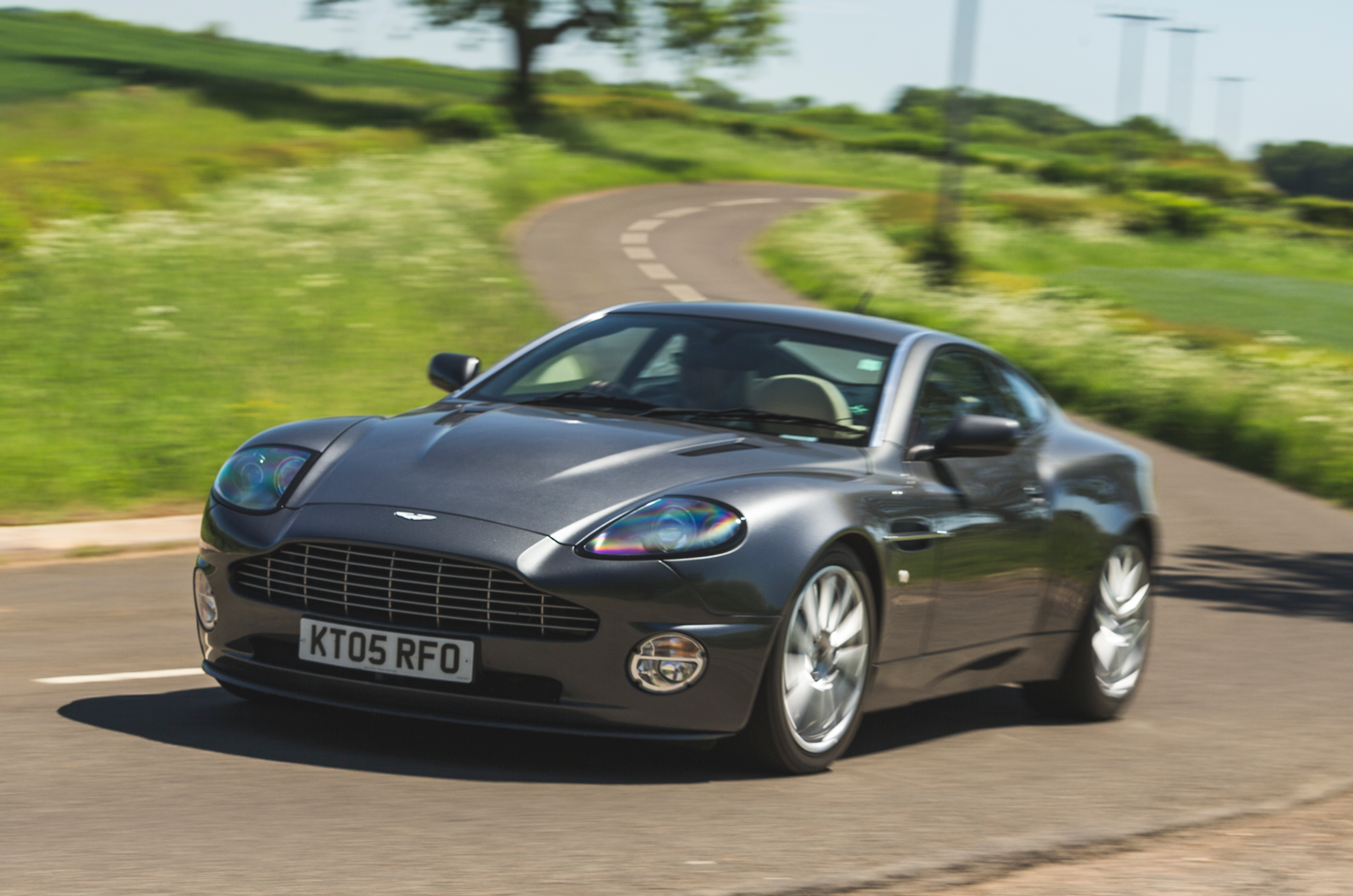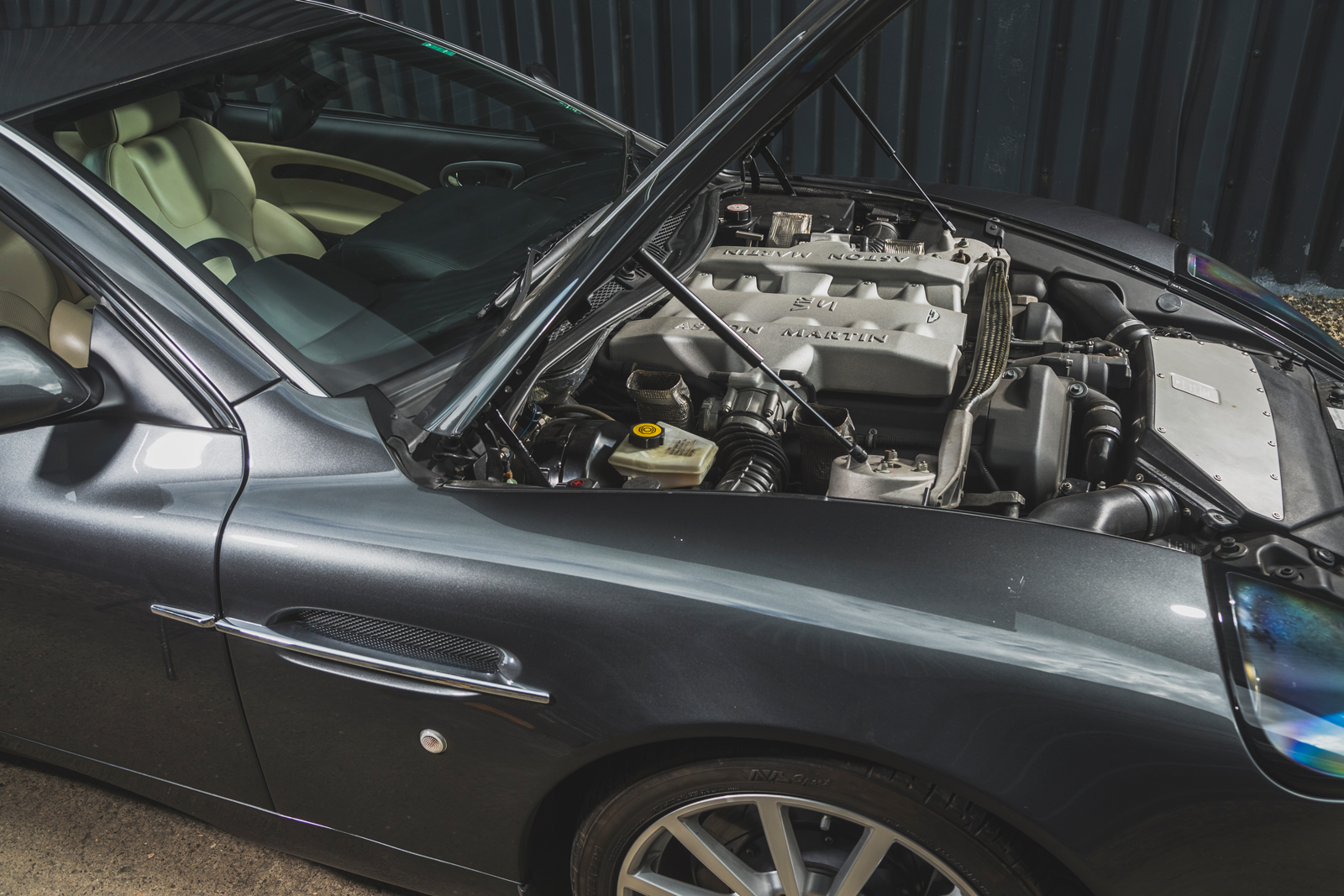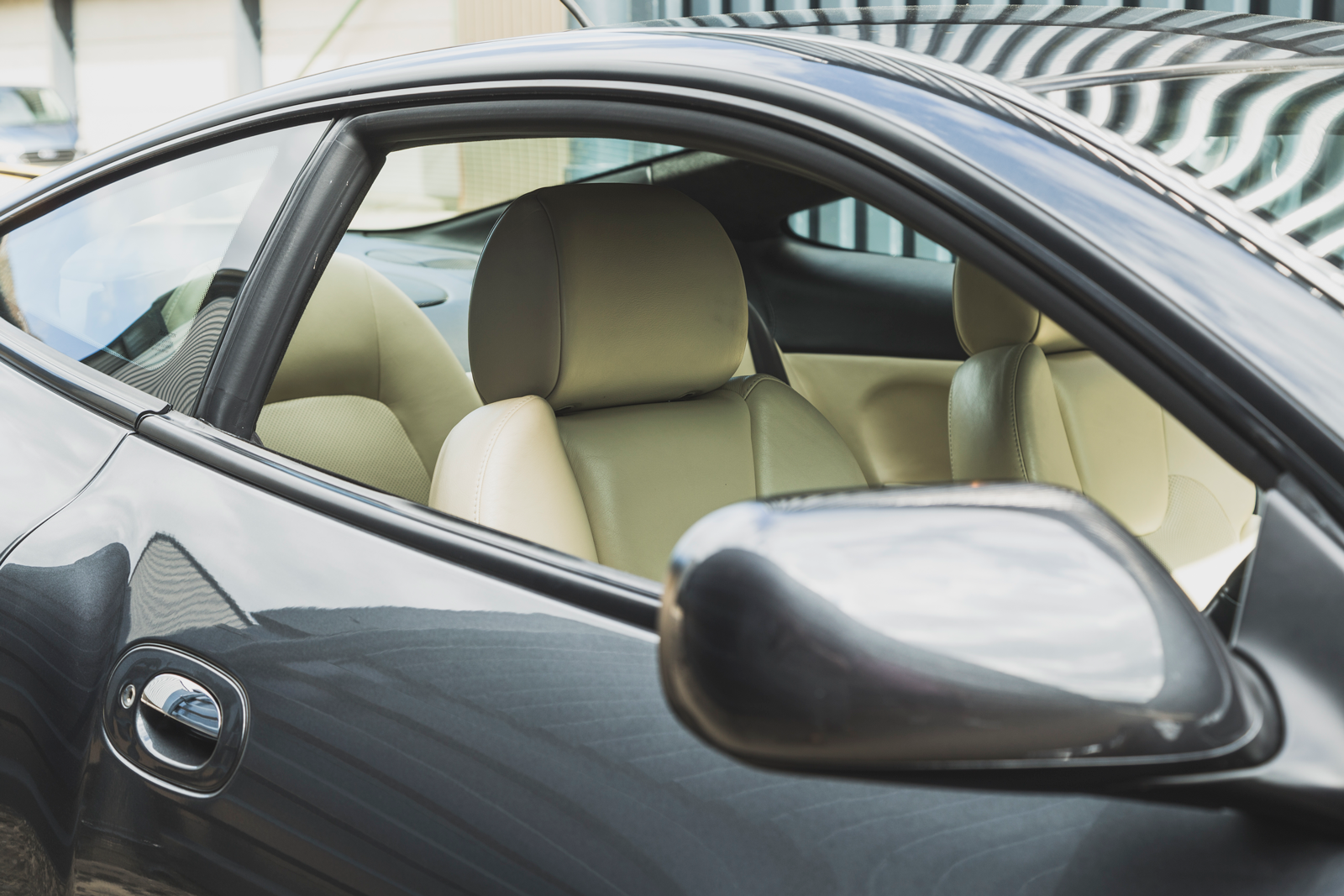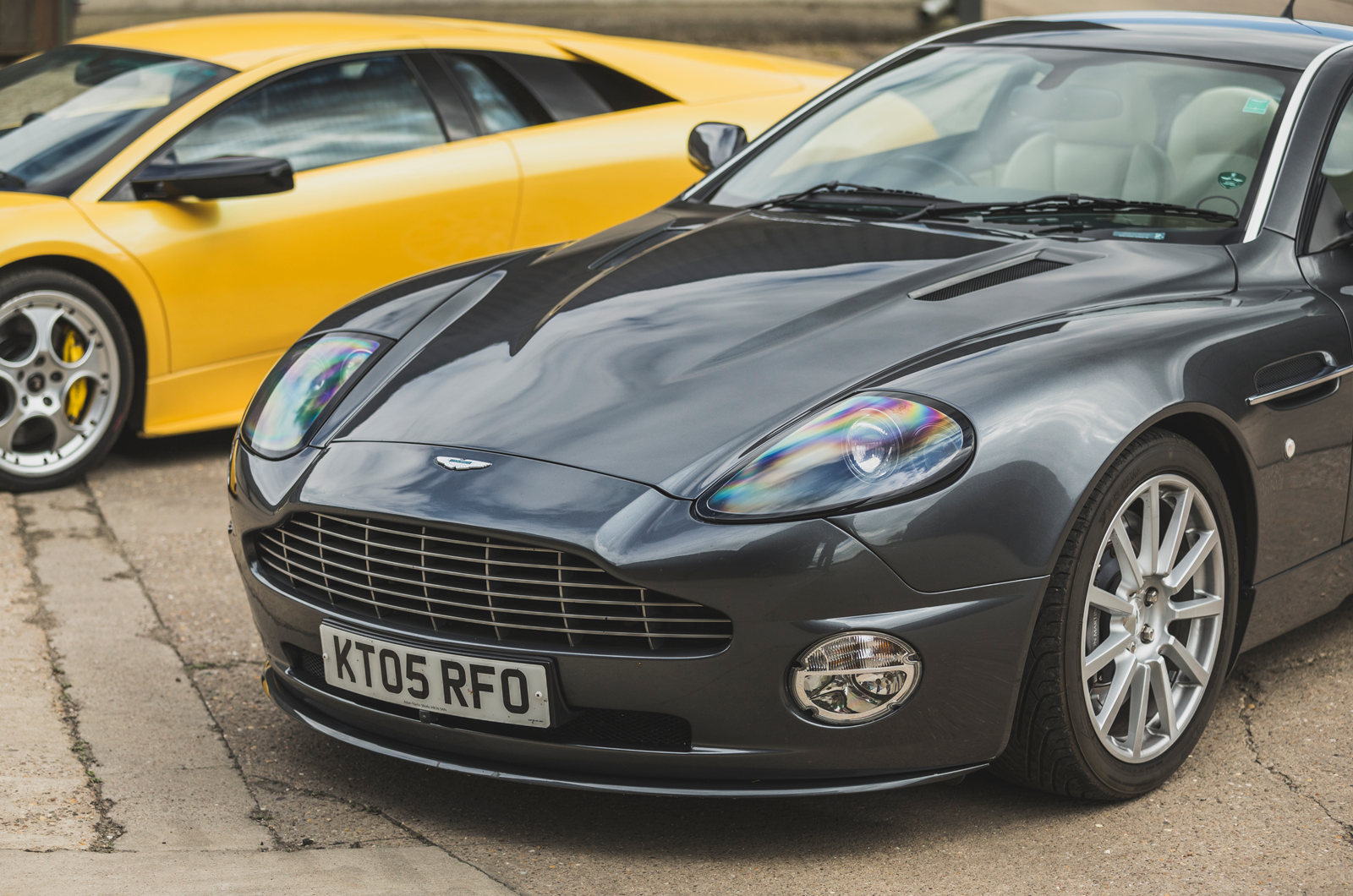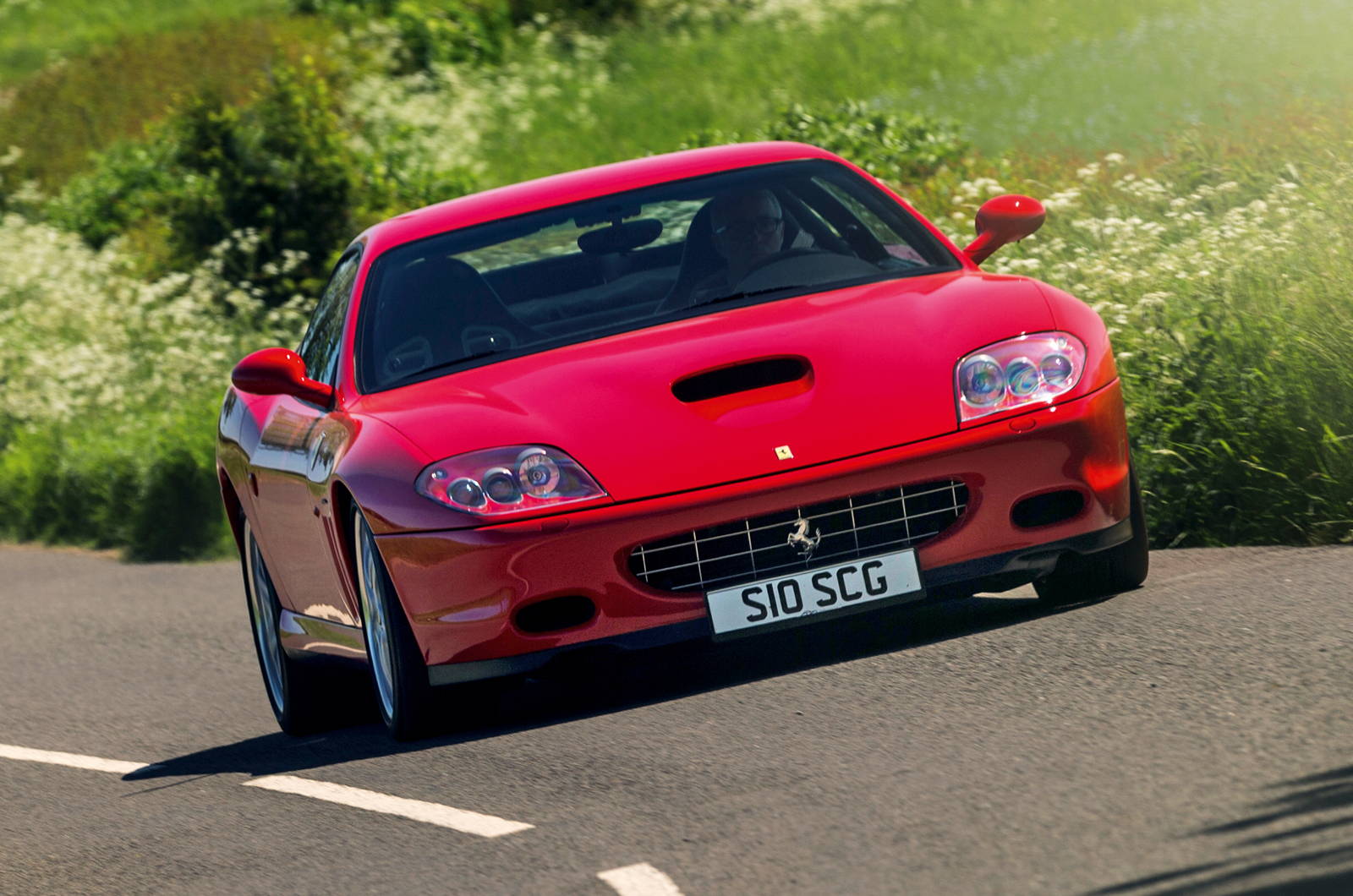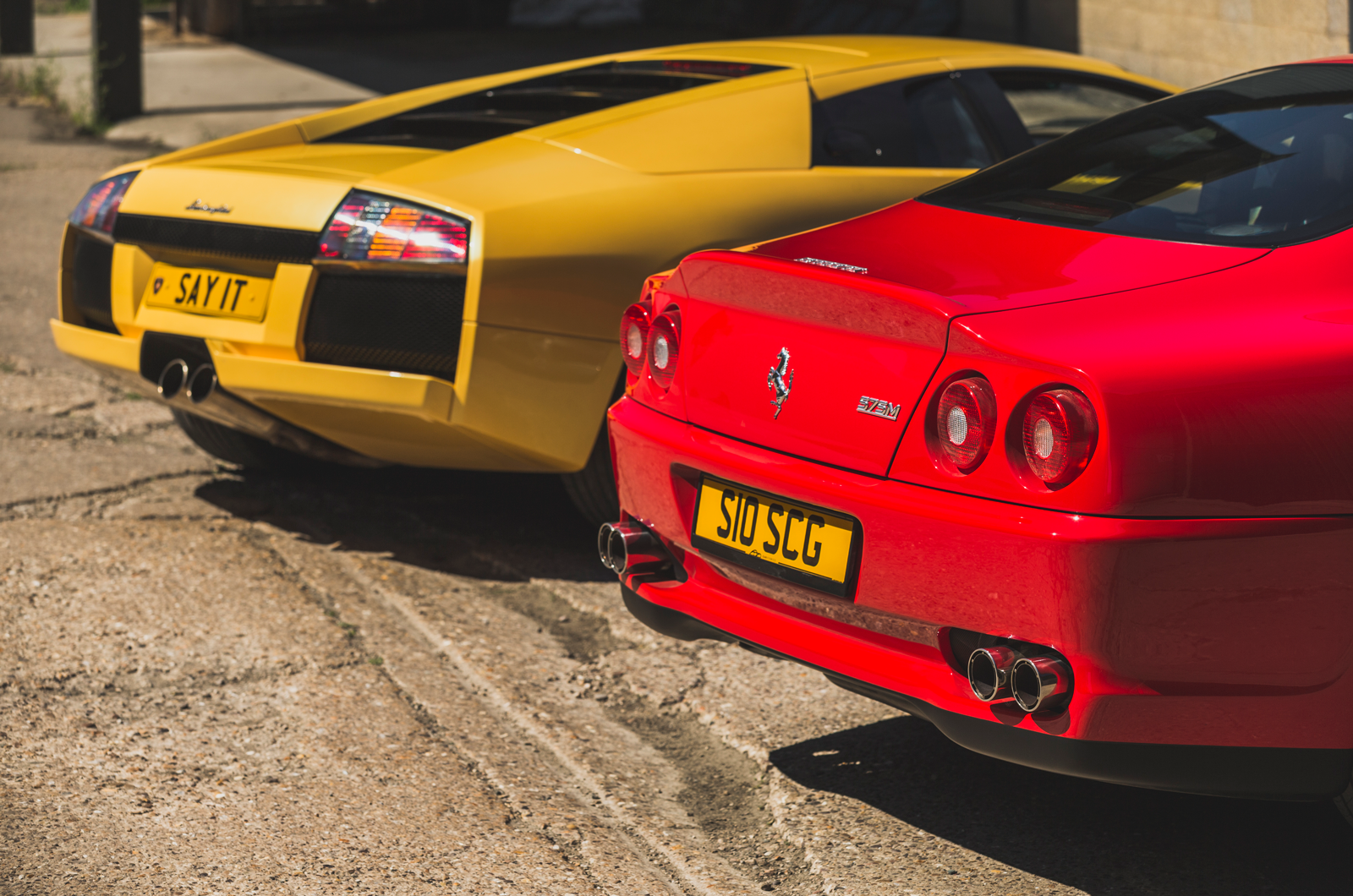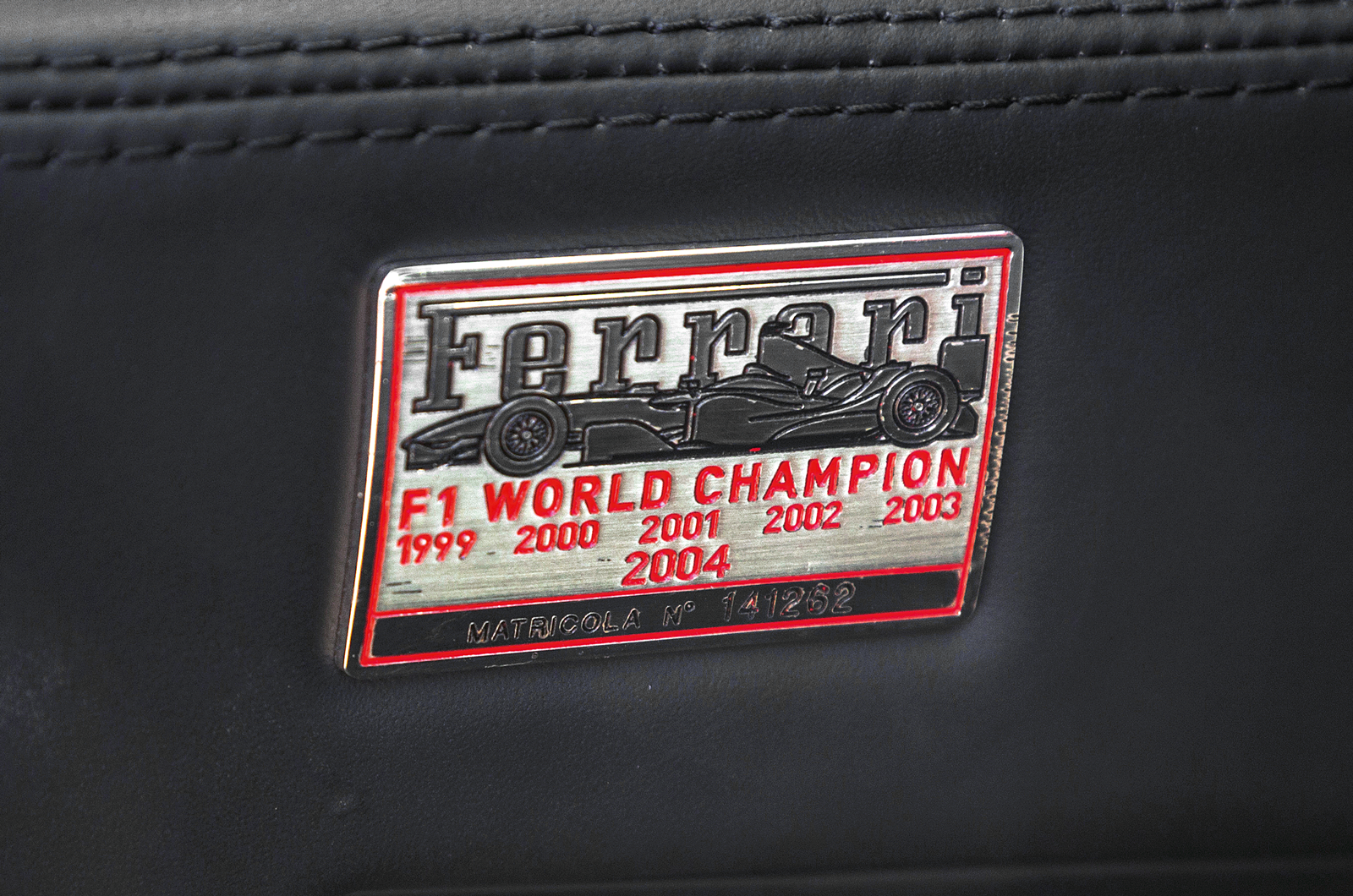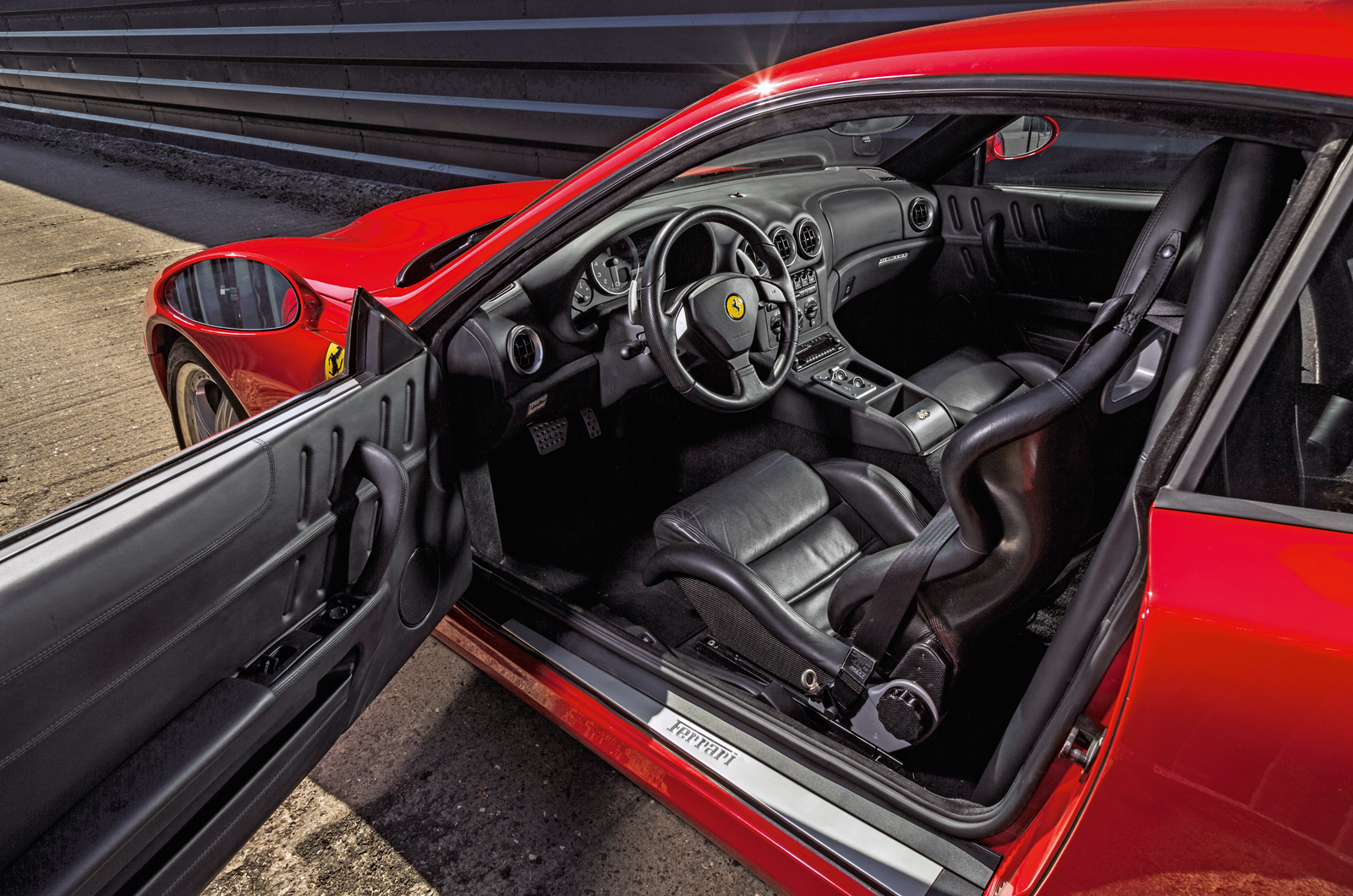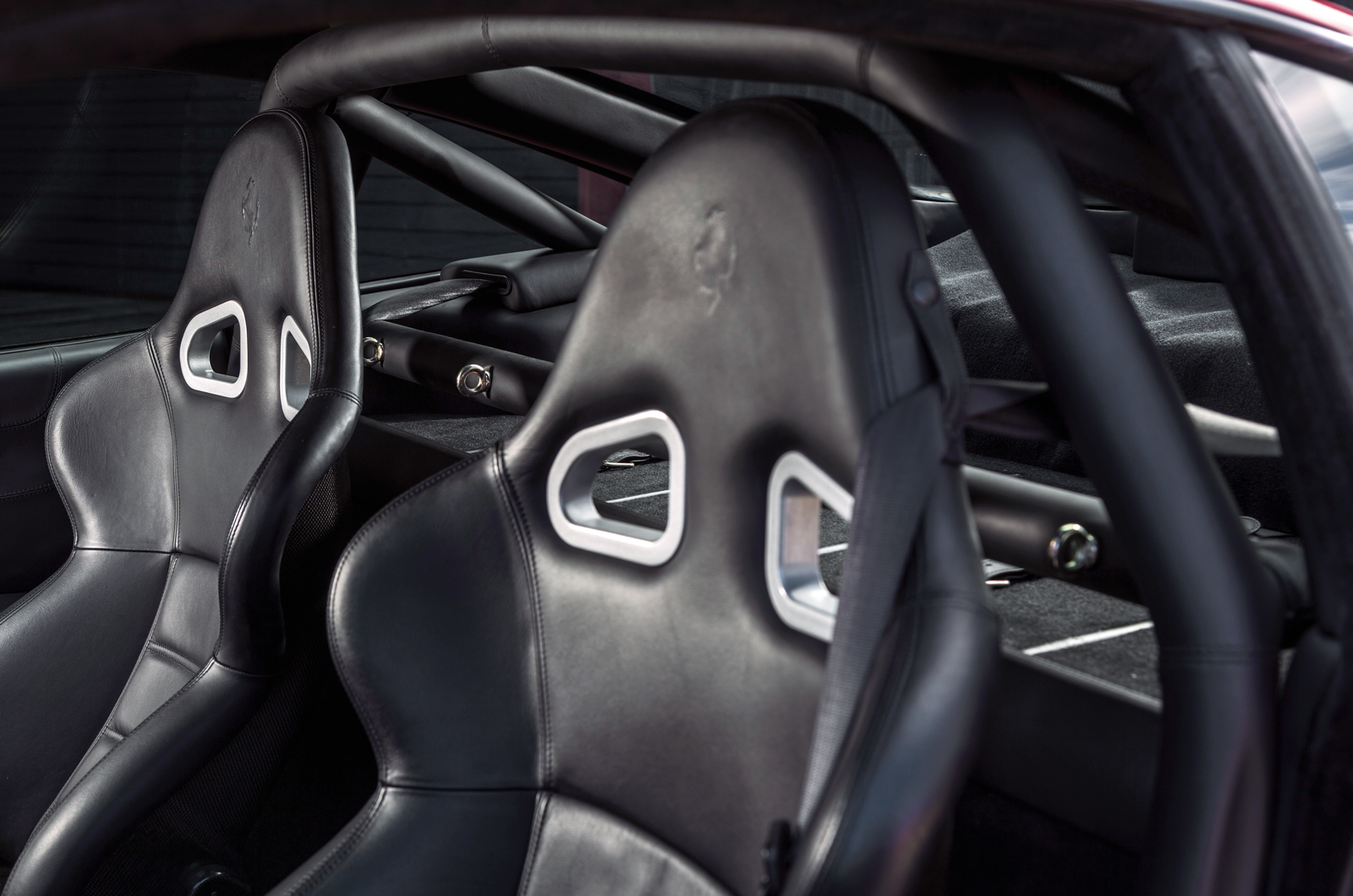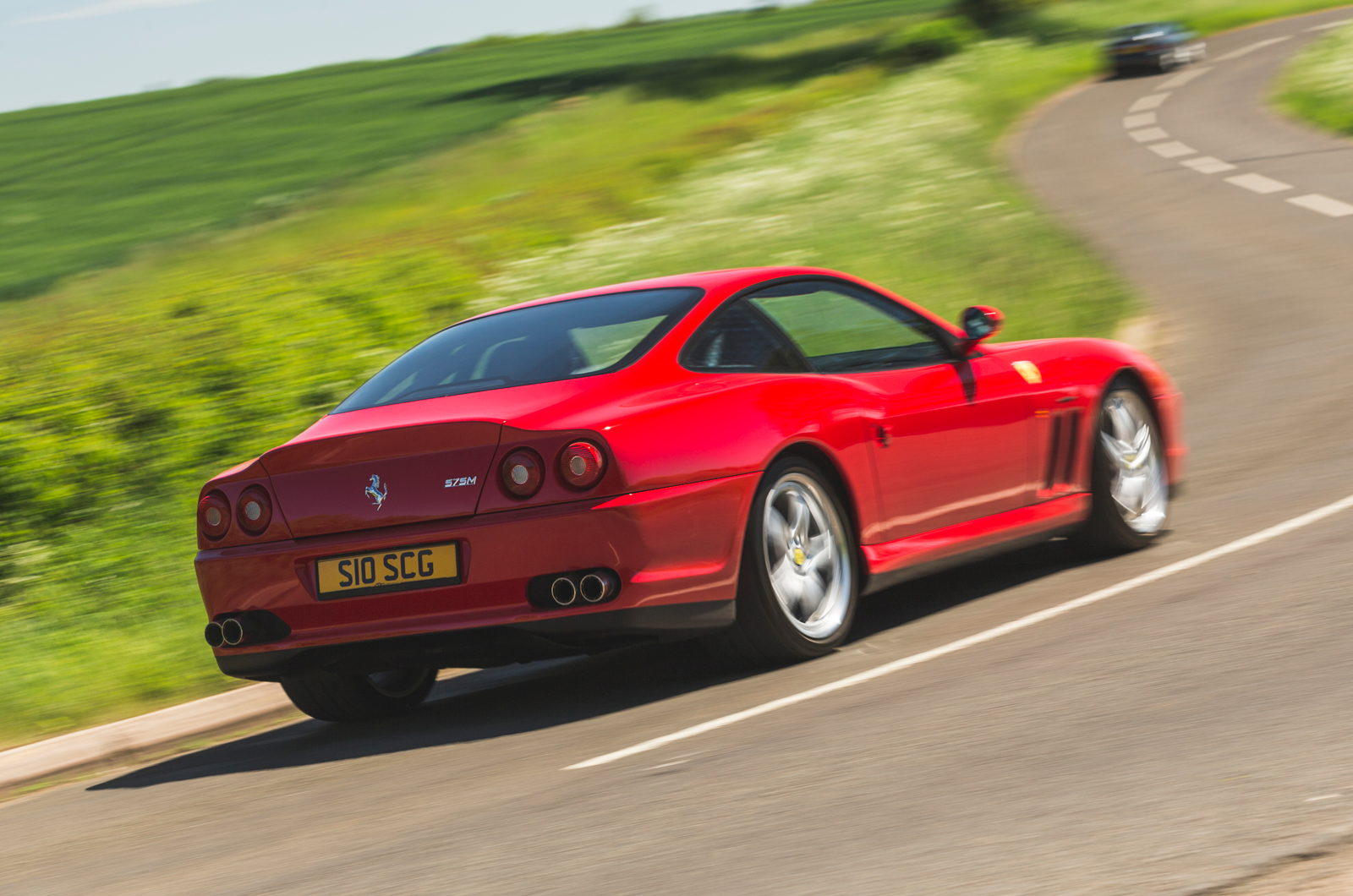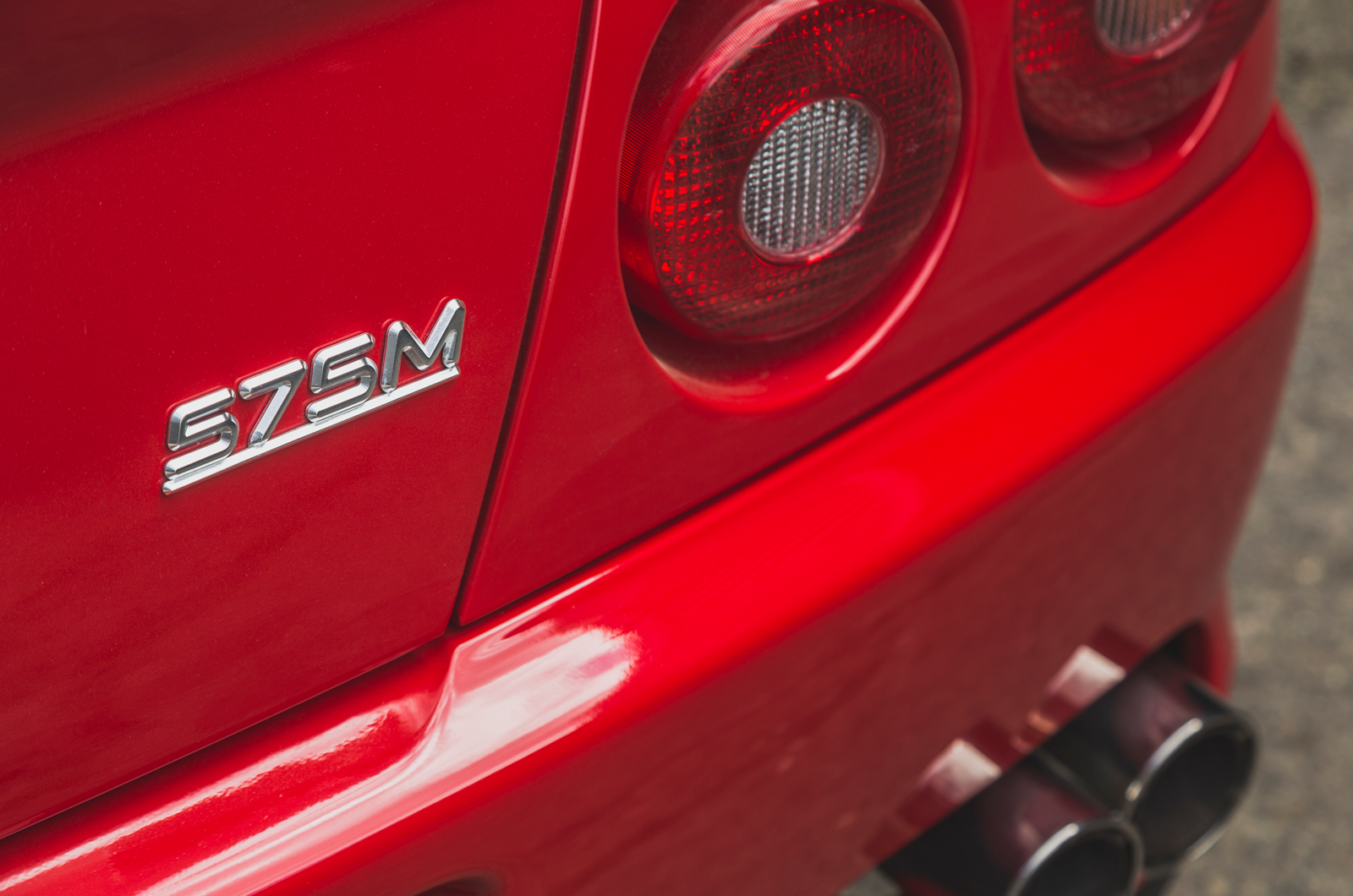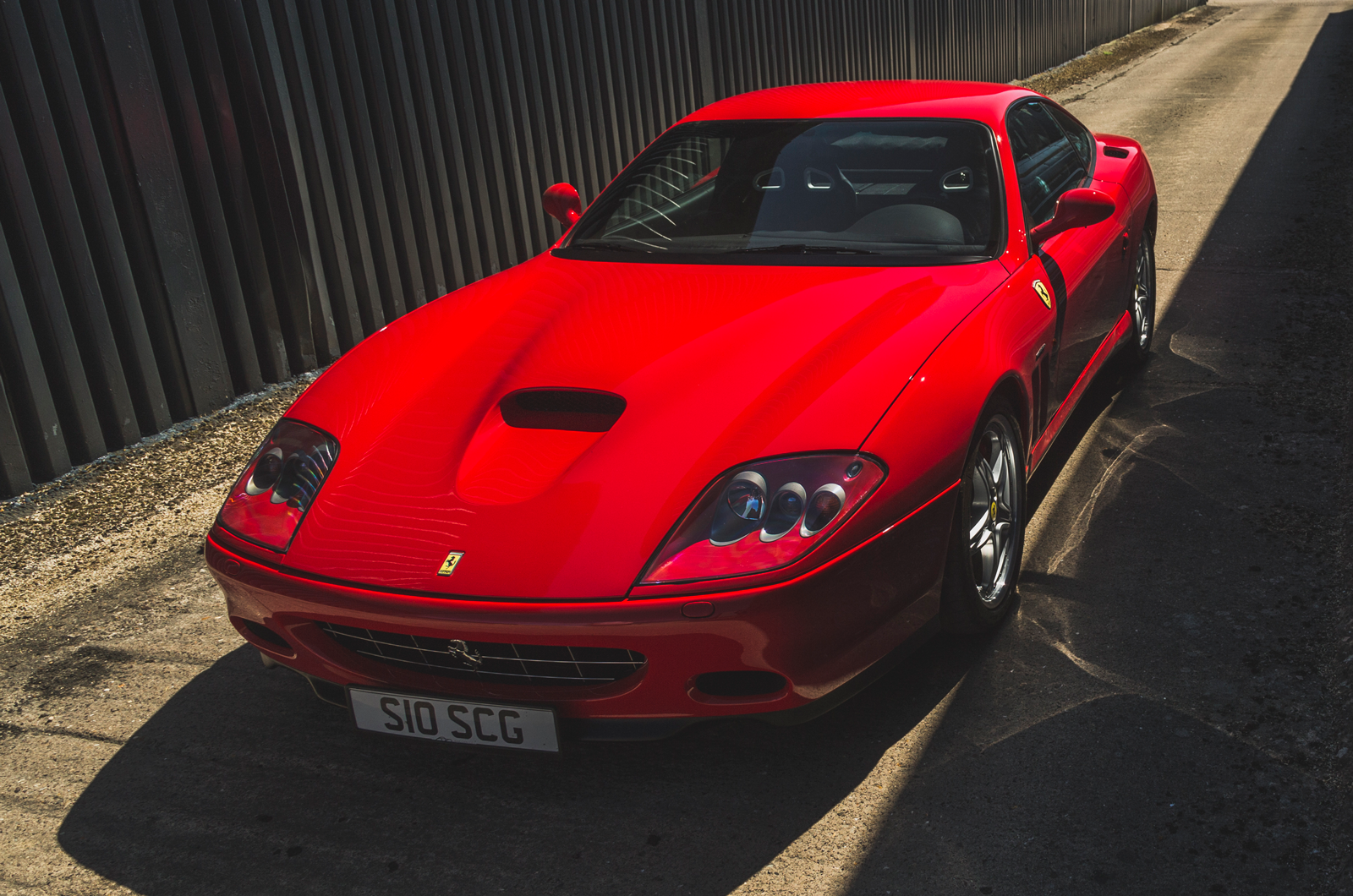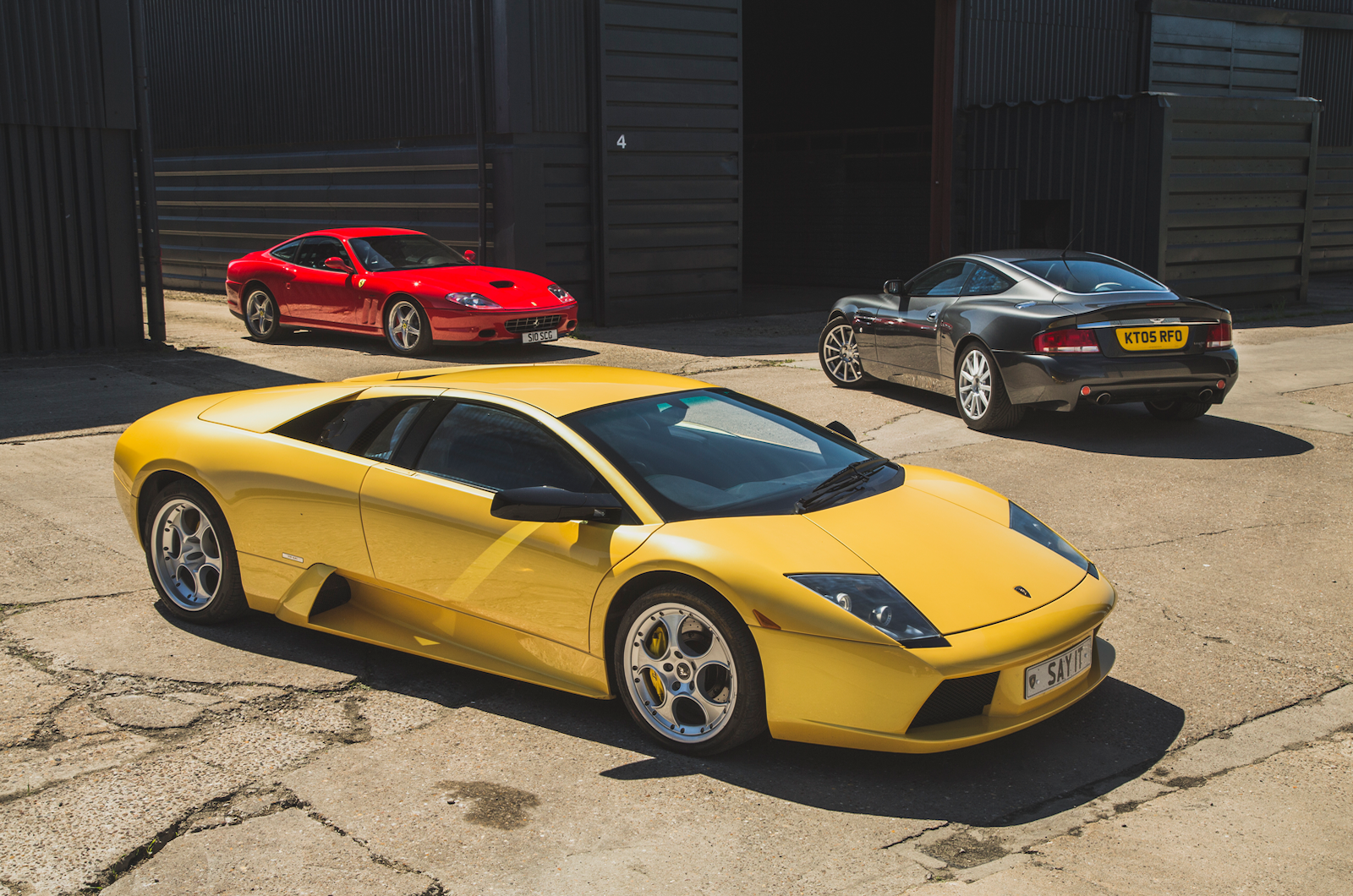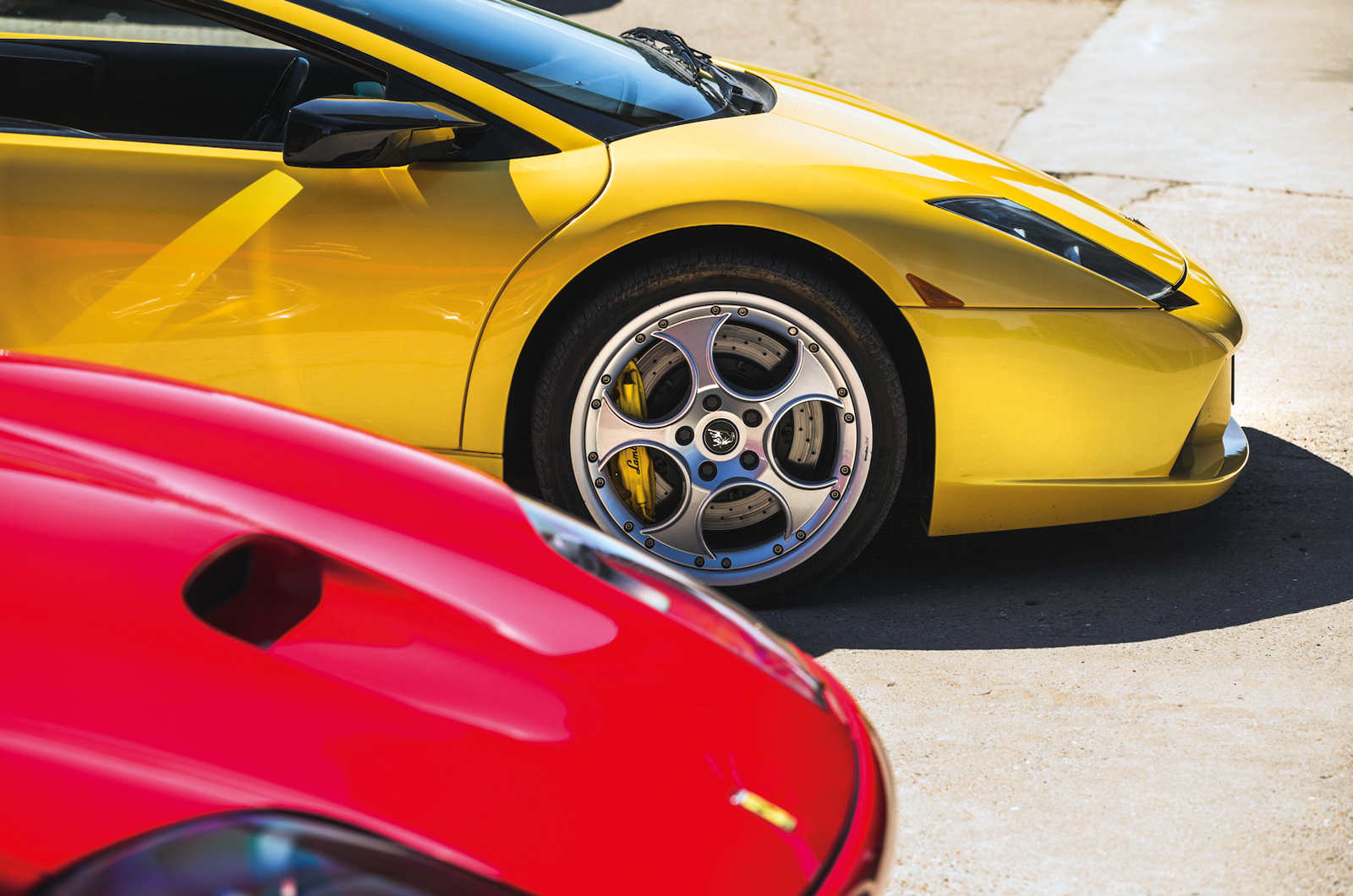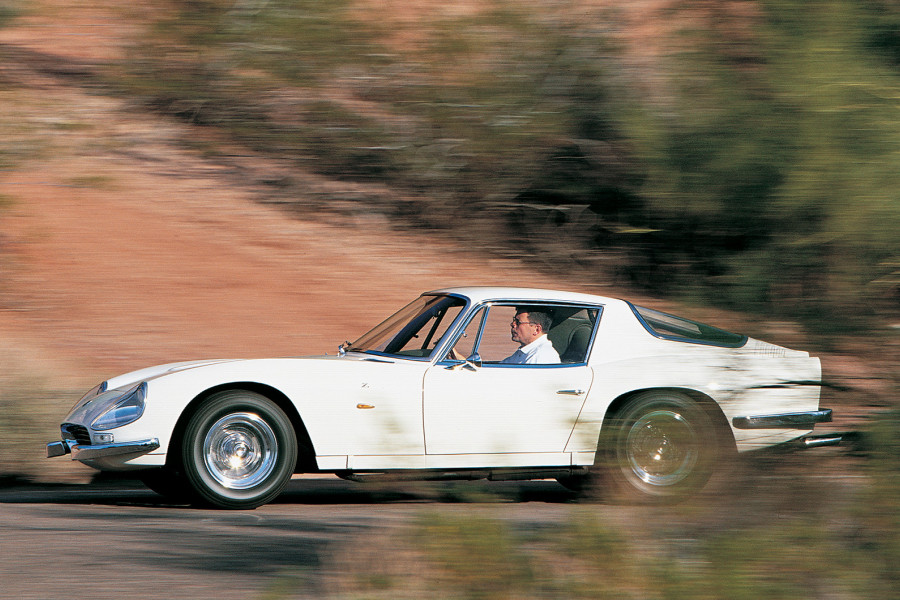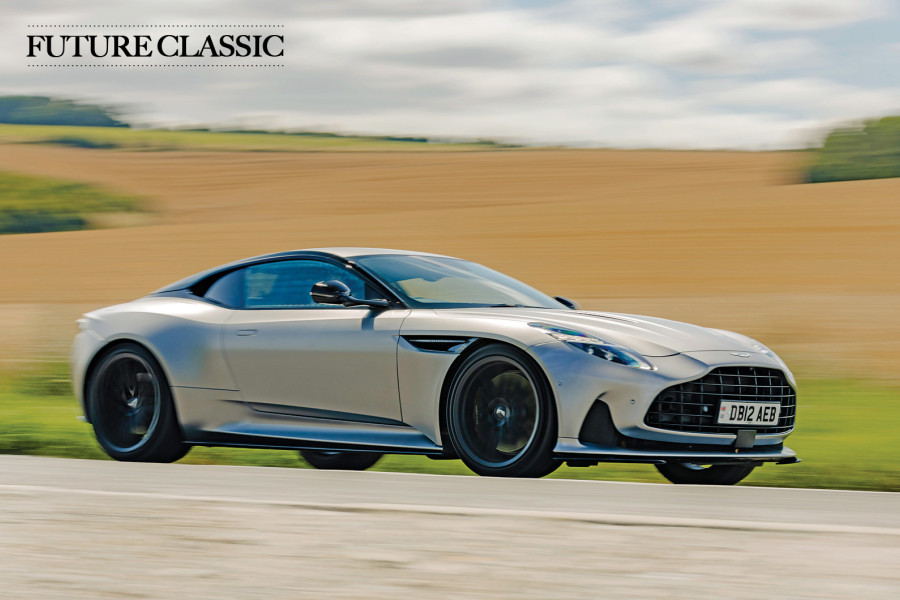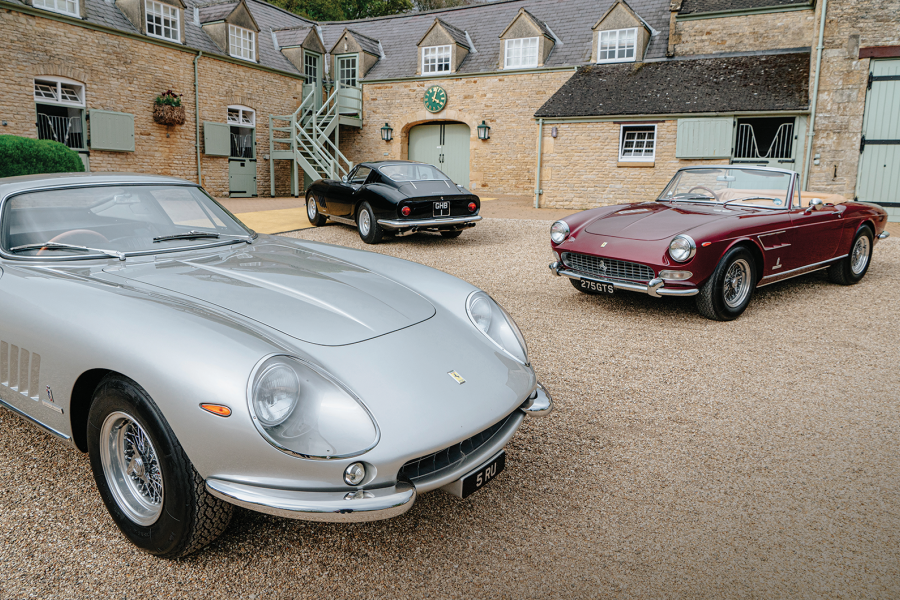These days pretty much all autos are either dual-clutchers or torque converters, but at the turn of the millennium the automated (or clutchless) manual was in vogue, essentially removing the clutch pedal and letting hydraulic actuation take care of shifting either automatically or by responding to commands tapped in on paddle-shifters fixed to the steering wheel or column.
The 575M and Murciélago offered manuals and automated manuals, but Aston went all-in on the new technology and the Vanquish’s ponderous shifts took more flak than a heavy bomber over occupied territory. Hence Aston Martin Works offering a manual conversion, and this one has receipts for more than £21k.
Upgrades such as lowered ride height and bigger brakes targeted the Ferrari 575M
A desirable upgrade, but it’s no match for the Lamborghini’s mechanical delicacy.
Here, the clutch bites early and physically, the shift is knuckly and heavy. A modern torque converter would strike a better balance.
The rest of this Vanquish S is as it left the factory, meaning that the uprated V12 is complemented by chassis and braking upgrades again conceived to put the Vanquish on terms with the Ferrari 575M.
These additions were bundled in the Sports Dynamic Package offered optionally on the Vanquish from 2004, but here they’re standard equipment, with 5mm lower suspension, uprated springs and dampers, larger brakes (six pistons and 378mm discs at the front) and 20% faster steering.
The Vanquish S strikes an odd compromise between a soft ride and crisp handling
Despite being an indecently rapid machine, the Vanquish easily feels – and is – the heaviest here, with a kerbweight of 1875kg (the Ferrari weighs 1730kg, the Lamborghini 1650kg) and a chassis that feels like a funny mix, as if it could manage that corpulence more precisely but also ride more compliantly.
On trickier surfaces the wheels feel heavy, and you’re aware of them individually deflecting, but there’s mush at both ends when you lean on the grip.
The V12 is pushed way back in the nose, though, so it turns in crisply and is pleasingly alert if you’re just a little more patient, and these are excellent brakes, with prompt and reassuring bite matched with highly effective stopping power.
Better to combine the Aston’s willingness to stop and turn on the way into corners with gentle throttle and a fraction of oversteer on the way out, something the reasonably liberal traction control system indulges.
Really, though, the Vanquish S shines brightest as a super-GT, effortlessly stretching its legs with easy pace, luxurious comfort and space to spare. Think more of a road trip to Le Mans than back-roads to Silverstone.
The Ferrari 575M is an upgraded version of the earlier 550
The Prancing Horse we’re driving is owned by Stephen Gannon, co-founder of the business along with his son, Daniel.
The Ferrari was produced from 2002 to 2006, following the 550 Maranello of 1996, and in many ways it splits the difference between the Lamborghini and the Aston, with sharper dynamics than the Brit but enhanced usability versus its countryman.
The 575M is technically an evolutionary tickle of its predecessor (the M suffix stands for modificato, or modified, and its reworked headlights are the most obvious difference), but the 550 had marked a significant turning point as Ferrari’s first two-seater V12 since 1973.
Michael Schumacher played a role in developing the Ferrari 575M
In the two decades before the 550, Ferrari made mid-engined V12 halo models that were comparable to the Murciélago and inspired by the Lamborghini’s predecessors; ever after it has reverted, save the special-series mid-engined hypercars, to the front-engined GTs on which the company laid its foundations.
Under the skin of aluminium panels there’s a tubular steel spaceframe, but the 65º V12 (its rivals favour a 60º vee) had grown from 5.5 to 5.7 litres, producing 508bhp at 7200rpm with 434lb ft of torque at 5250rpm.
Ferrari offered three pedals, but here there’s a tiny little joystick in place of the gated manual.
It’s Ferrari’s first automated manual and was dubbed ‘F1’, which at the time was something to celebrate: ‘F1 world champions 1999, 2000, 2001, 2002, 2003 and 2004,’ says the plaque in this (Schumacher-developed) car.
A purposeful, yet still plush, interior makes the Ferrari 575M feel focused
The 575M interior was also uprated. Wrapped in black leather, it is surprisingly Germanic and quite austere in here, with a lean focus like leather skins drawn tight over drums: it’s in everything from gorgeous carbonfibre-backed seats that clamp you firmly but comfortably, to the contours of the dash architecture, to the chronograph precision of the central tacho; even the firm, perfectly formed shape of the steering wheel.
It makes the Aston in particular look flabby and sprawling, and there’s no question that this is our best-of-the-bunch driving position: low down, pedals dead ahead, great visibility.
The 575M’s short wheelbase helps its agility
It’s an elegant car and the shortest here, and in profile your eye is drawn to a wheelbase that is shorter still in relation to the others.
You notice that in the length of the overhangs and feel it in how nimble and reactive the Ferrari is.
Not all 575s drive so well, however.
An expensive upgrade package rectified many wrongs in the 575M
The 575M was criticised in period for feeling like a flabbier 550, and Ferrari did offer the Fiorano package for keener drivers, a £2215 handling upgrade named after its private test track.
But this car gets the Handling GTC Package, which took improvements a leap further in 2004.
For £16,450 (on top of £163,200 with the F1 gearbox), you got suspension lowered by 15mm, with front spring rates increased by 33%, rears by 15%, plus uprated adaptive Sachs dampers and a 75% stiffer rear anti-roll bar.
As with the Fiorano pack, a new ECU reduced steering assistance for a meatier feel.
The wheels grew from 18 to 19in, and HGTC models also received a Brembo carbon-ceramic brake upgrade borrowed from the Enzo.
The Ferrari 575M’s V12 is less orchestral than its rivals
I’ve driven both a standard 575 and this very car around Rockingham race circuit and the difference was huge, with the standard car’s soft rear end and spongy brake pedal quickly knocking confidence and precision.
The HGTC’s extra focus translates well to the road, too.
The V12 doesn’t sound as exotic as the Lamborghini nor as musclebound as the Aston, but it is still compelling, still with a throttle response that buzzes like an electric fence, it’s just less spine-tinging, more mechanical.
The 575M feels especially eager at low speeds
Bloody quick, though: the lower gear ratios feel more tightly stacked than the Lamborghini or the Aston, so you punch through them in a bit of a blur on the paddles, but third gives you more time to appreciate the build-up as you dip into the long-travel accelerator, where it’s tractable and malleable at low revs and bursts with a second wave of enthusiasm above 4000rpm that intensifies ferociously right up to peak revs.
The automated-manual gearshifts can be a little dopey in the default mode (lifting the throttle between shifts helps), but they wake up with a prod of the Sport button, leaving very little to complain about.
Sport also firms the dampers, which even proactively react to the pauses between gearshifts to keep the body stable, although it adds a brittleness to the ride.
The Ferrari 575M with the HGTC package is an easy car to drive well
But there’s no doubt that the 575M is the best balanced, most exploitable and most confidence-inspiring car in this trio.
The brake pedal is instantly taut, with easily modulated pressure and monster stopping power; the steering crackles with communication and its weight is beautifully judged; and that compact wheelbase means it changes direction like a featherweight boxer.
The 575 also oversteers very casually, if with a lovely fluid and predictable balance: leave the traction control in Sport and your hands can move from quarter-to-three to twenty-five-to-one without a hint of intervention.
It’s this mix of predictability, stability and playfulness that makes the 575M the car I’d prefer to be in if I arrived at a corner ahead of schedule and in a bit of a panic.
There are more differences among these three cars than the factfiles suggest
Three V12s, then, and three very different choices.
Of all these cars, the Vanquish is the easiest to dismiss, impressive as it is as a long-distance GT, and as gorgeous as it looks and sounds.
It could feel sharper and still hit its refinement targets.
The Ferrari 575M is the sensible choice, but the Lamborghini Murciélago leaves a distinct impression
The Ferrari is the car to cover all bases.
It represents fantastic value for money, with prices typically £70k and up for base 575s, and, as the Gannons attest, can crack an indicated 201mph on the way to the Nürburgring and be a bundle of fun all the way round, too.
It’s a smart choice if you’ve saved all your life to buy one supercar and need it to do everything.
But the supercar to add to your dream collection, to take out on high days and holidays and drive as if you’re outrunning the apocalypse? That’ll be the Lamborghini.
Images: Luc Lacey
Thanks to Car-Iconics
Factfiles
Aston Martin Vanquish S
- Sold/number built 2001-’07/1492 (Vanquish), 1086 (Vanquish S)
- Construction bonded aluminium and carbonfibre monocoque
- Engine all-alloy, dohc-per-bank 5935cc V12, fuel injection
- Max power 520bhp @ 7000rpm
- Max torque 426lb ft @ 5800rpm
- Transmission six-speed manual, RWD
- Suspension independent, by wishbones, coil springs, telescopic dampers f/r
- Steering power-assisted rack and pinion
- Brakes discs, with servo and anti-lock
- Length 15ft 3in (4665mm)
- Width 6ft 3in (1923mm)
- Height 4ft 3in (1318mm)
- Wheelbase 8ft 8in (2690mm)
- Weight 4134lb (1875kg)
- 0-60mph 4.8 secs
- Top speed 199mph
- Mpg 15
- Price new £195,950
- Price now from £90,000*
Lamborghini Murciélago
- Sold/number built 2001-’10/4099
- Construction tubular steel spaceframe with carbonfibre reinforcement, carbonfibre, steel and aluminium body
- Engine all-alloy, dohc-per-bank 6192cc V12, fuel injection
- Max power 572bhp @ 7500rpm
- Max torque 479lb ft @ 5400rpm
- Transmission six-speed manual, 4WD
- Suspension independent, by wishbones, coil springs, telescopic dampers f/r
- Steering power-assisted rack and pinion
- Brakes discs, with servo and anti-lock
- Length 15ft (4580mm)
- Width 6ft 7in (2045mm)
- Height 3ft 7in (1135mm)
- Wheelbase 8ft 7in (2665mm)
- Weight 3638lb (1650kg)
- 0-60mph 3.8 secs
- Top speed 205mph+
- Mpg 13.2
- Price new £170,038
- Price now from £140,000*
Ferrari 575M HGTC
- Sold/number built 2002-’06/2056
- Construction tubular steel spaceframe, aluminium body
- Engine all-alloy, dohc-per-bank 5748cc V12, fuel injection
- Max power 508bhp @ 7200rpm
- Max torque 434lb ft @ 5250rpm
- Transmission six-speed automated manual, RWD
- Suspension independent, by wishbones, coil springs, telescopic dampers f/r
- Steering power-assisted rack and pinion
- Brakes discs, with servo and anti-lock
- Length 14ft 11in (4550mm)
- Width 6ft 3in (1935mm)
- Height 4ft 2in (1277mm)
- Wheelbase 8ft 2in (2500mm)
- Weight 3814lb (1730kg)
- 0-60mph 4.2 secs
- Top speed 203mph
- Mpg 13
- Price new £163,200 (plus £16,450 for Handling GTC Package)
- Price now from £70,000 (non-HGTC)*
*Price correct at date of original publication
READ MORE
Ferrari Mondial: From zero to hero
20 of the best Pininfarina classics
Driving a rare Jaguar XJ220 prototype
Ben Barry
Ben Barry is a contributor to Classic & Sports Car

